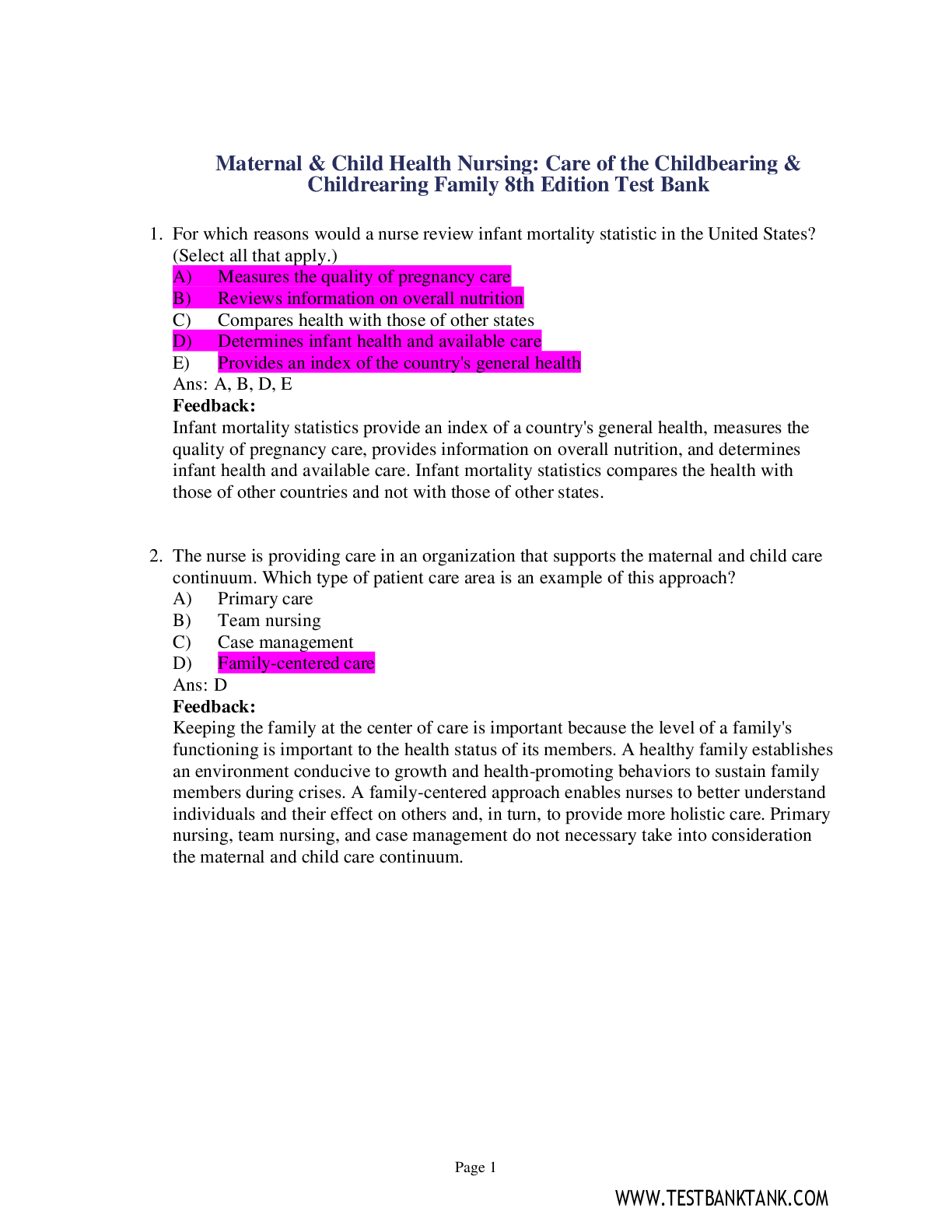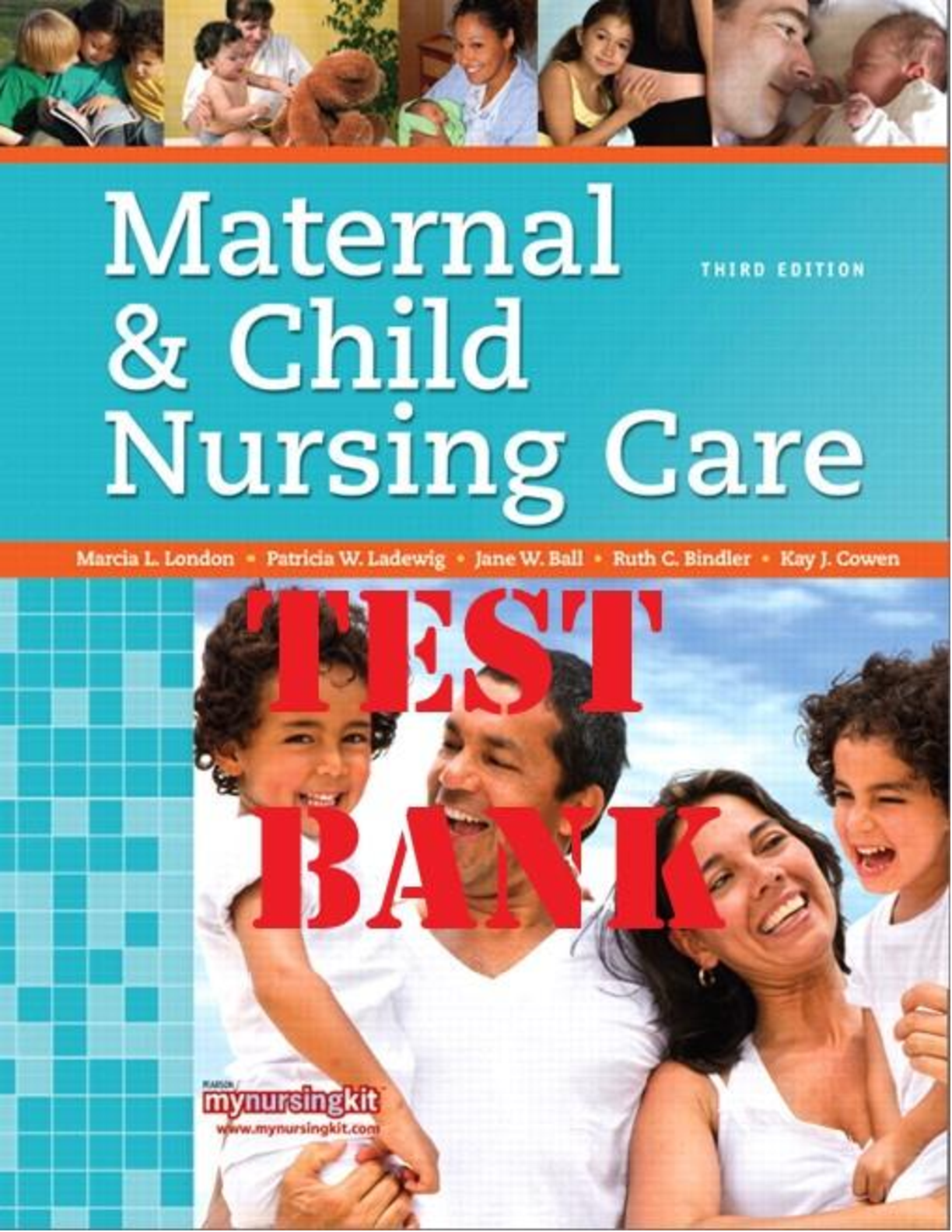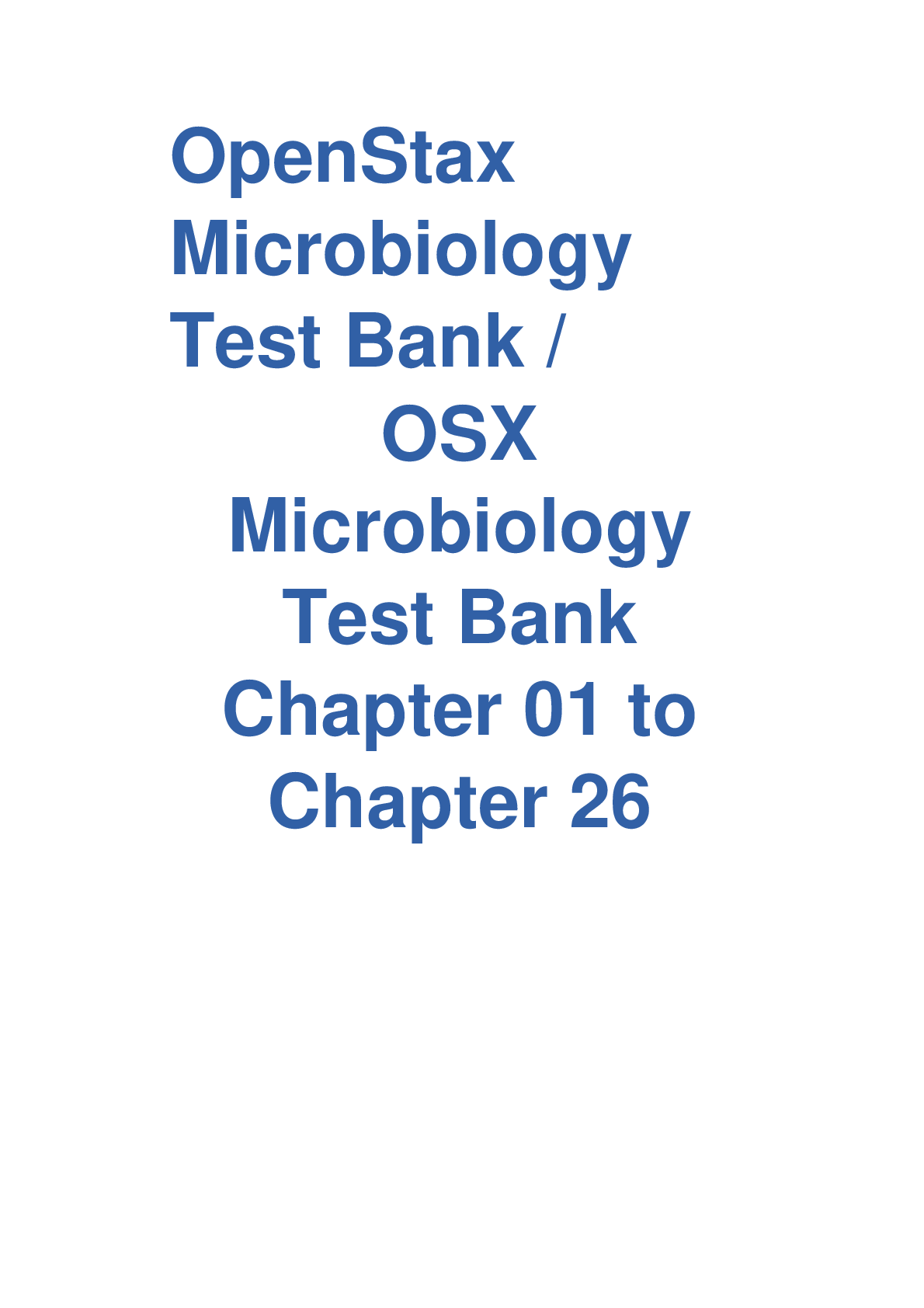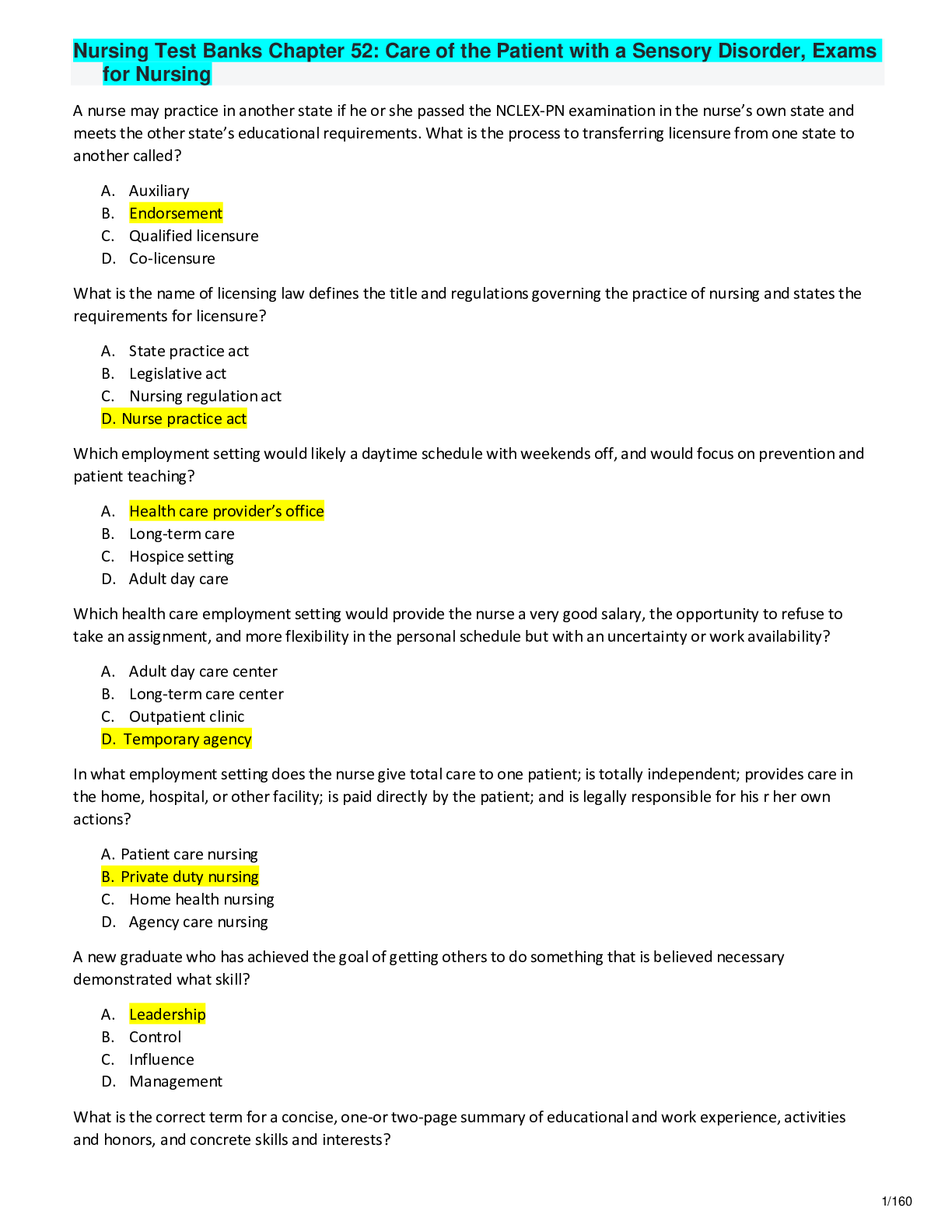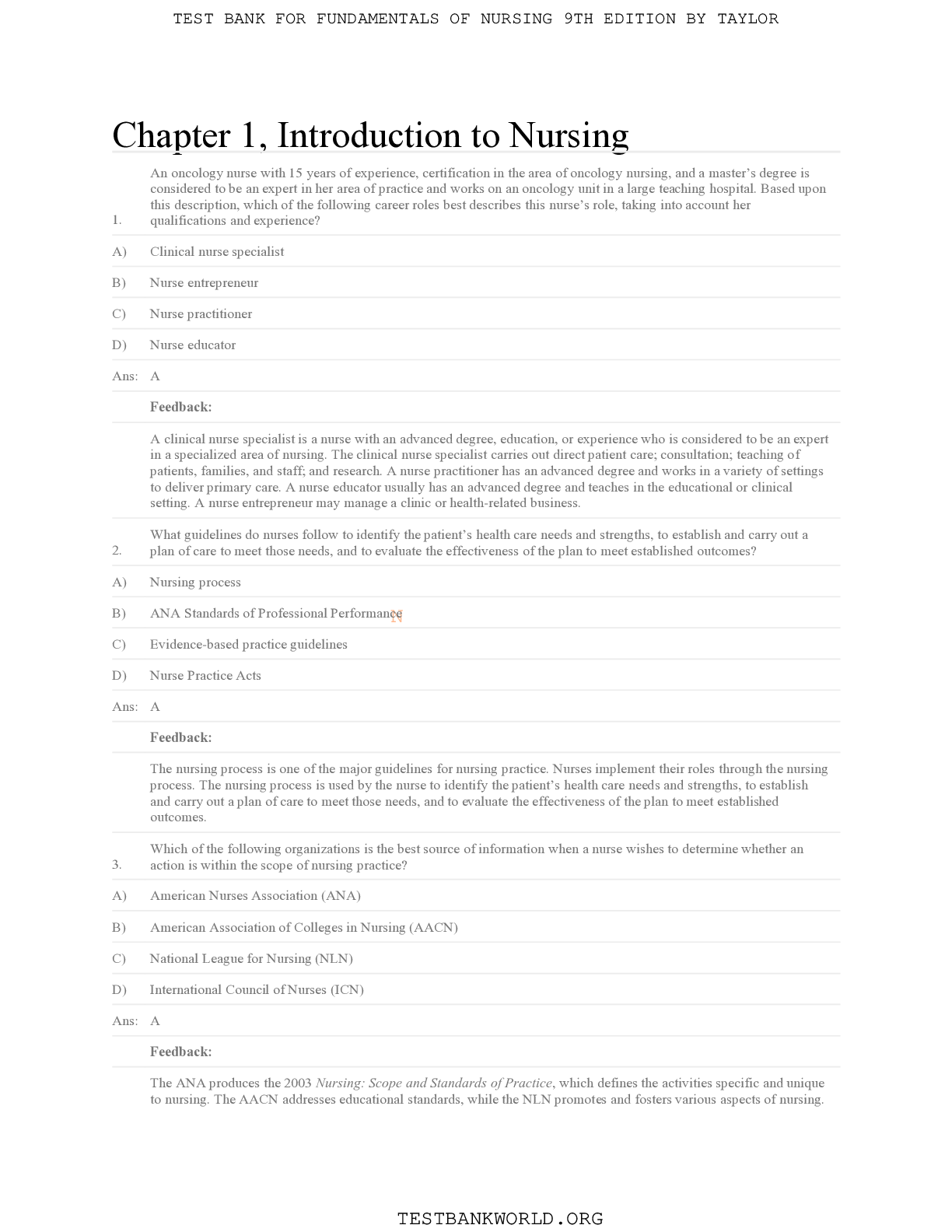*NURSING > TEST BANK > Maternal & Child Health Nursing: Care of the Childbearing & Childrearing Family 8th Edition Test Ban (All)
Maternal & Child Health Nursing: Care of the Childbearing & Childrearing Family 8th Edition Test Bank / Instant Test Bank For Maternal & Child Health Nursing: Care of the Childbearing & Childrearing Family 8th Edition Authors: JoAnne Silbert-Flagg, Pillit
Document Content and Description Below
Maternal & Child Health Nursing: Care of the Childbearing & Childrearing Family 8th Edition Test Bank / Instant Test Bank For Maternal & Child Health Nursing: Care of the Childbearing & Childrearing F... amily 8th Edition Authors: JoAnne Silbert-Flagg, Pillit Page 1 1. For which reasons would a nurse review infant mortality statistics in the United States? (Select all that apply.) A) Measures the quality of pregnancy care B) Reviews information on overall nutrition C) Compares health with those of other states D) Determines infant health and available care E) Provides an index of the country's general health Ans: A, B, D, E Feedback: Infant mortality statistics provide an index of a country's general health, measures the quality of pregnancy care, provides information on overall nutrition, and determines infant health and available care. Infant mortality statistics compares the health with those of other countries and not with those of other states. 2. The nurse is providing care in an organization that supports the maternal and child care continuum. Which type of patient care area is an example of this approach? A) Primary care B) Team nursing C) Case management D) Family-centered care Ans: D Feedback: Keeping the family at the center of care is important because the level of a family's functioning is important to the health status of its members. A healthy family establishes an environment conducive to growth and health-promoting behaviors to sustain family members during crises. A family-centered approach enables nurses to better understand individuals and their effect on others and, in turn, to provide more holistic care. Primary nursing, team nursing, and case management do not necessary take into consideration the maternal and child care continuum.Page 2 3. Which actions should the nurse perform when supporting the goals of maternal and child health care? (Select all that apply.) A) Advocates protecting the rights of the mother and fetus B) Teaches family members interventions to improve health C) Adheres to principles that focus on the needs of the mother D) Encourages maternal hospitalization to regain strength and stamina E) Assesses family members for strengths and specific needs or challenges Ans: A, B, E Feedback: Actions that the nurse should perform when supporting the goals of maternal and child health care include advocating the rights for the mother and fetus, teaching health promotion interventions, and assessing the family for strengths and specific needs or challenges. Adhering to principles that focus on the needs of the mother and encouraging maternal hospitalization to regain strength and stamina are not actions that support the goals of maternal and child health care. 4. The nurse is reviewing the 2020 National Health Goals and notes that which is a focus of these goals? A) Health promotion and disease prevention B) Early diagnosis of chronic health problems C) Effective use of medication to treat disease D) Reduce the cost of health care and medications Ans: A Feedback: The 2020 National Health Goals are intended to help citizens more easily understand the importance of health promotion and disease prevention and to encourage wide participation in improving health in the next decade. These goals do not focus on the early diagnosis of chronic problems, use of medications to treat disease, or reduce the cost of health care and medications.Page 3 5. The nurse has noticed a change in the type of care needed to support maternal and child health issues. What does the nurse realize as reasons for the changes in care? (Select all that apply.) A) Smaller families B) Less domestic violence C) More employed mothers D) Stable home environments E) More single-parent families Ans: A, C, E Feedback: Nursing care for maternal and child is changing because families are smaller, more mothers are employed out of the home, and there are more single-parent families. There is an increase in domestic violence, and families are less stable and more mobile, which influences homelessness. 6. During an assessment, the nurse asks a patient from a non-English-speaking culture which types of home remedies and herbs the patient uses for health care. What is the purpose of asking the patient this question? A) Analyze for herb–drug interactions B) Understand the patient's philosophy of alternative health care C) Determine the types of medications the patient will need to be prescribed D) Explain to the physician the patient's preference for nontraditional medicine approaches Ans: A Feedback: Assessing what alternative measures are being used is important because the action of an herb can interfere with prescribed medications. Assessing the use of herbal remedies is not done to understand the patient's philosophy of alternative health care, determine the types of medications the patient will need to be prescribed, or explain the patient's preferences for nontraditional medicine approaches to the physician.Page 4 7. The nurse notes that statistics on maternal mortality had improved but are again becoming elevated. What does the nurse realize as a reason for this change in maternal mortality rates? A) Earlier prenatal care B) Gestational hypertension C) Increased vaginal deliveries D) Treatment for chronic diseases Ans: B Feedback: This increasing rate in maternal mortality is associated with more cesarean births, more gestational hypertension related to preexisting hypertensive disorders, and lack of health insurance for many Americans. This increase is not because of earlier prenatal care, increased vaginal deliveries, or treatment for chronic diseases. 8. A new mother asks the nurse if all of the new baby's injections can be given in one visit because the mother is losing income from missing work because of the office visits. What does this new mother's issue indicate to the nurse? A) The mother needs to find an alternative employer. B) The mother's income is more important that the baby's health. C) Missing work does not support the baby's health maintenance visits. D) The federal government needs to do more to support well-baby visits. Ans: C Feedback: An area that needs additional research is finding effective stimuli to encourage women to bring children for health maintenance visits. The mother losing income because of missing work for well-baby visits will deter health maintenance visits for the baby going forward. This mother's issue does not indicate that the mother needs to find another job, that the mother's income is more important that the baby's health, or that the federal government needs to do more to support well-baby visits.Page 5 9. The nurse works in a maternal and child care area that supports health promotion. Which activities will the nurse perform to support this philosophy of health care? (Select all that apply.) A) Planning care B) Patient teaching C) Family counseling D) New mother advocacy E) Identifying nursing diagnoses Ans: B, C, D Feedback: Extensive changes in the scope of maternal and child health nursing have occurred as health promotion has become a greater priority in care. The nursing activities for health promotion include teaching, counseling, and advocacy. Planning care and identifying nursing diagnoses are a part of the nursing process and not specific to health promotion. 10. During a care conference, a nurse provides everyone with a copy of the latest research on improving the success of breastfeeding for first-time mothers. Which Quality & Safety Education for Nurses competency does this nurse's action support? A) Quality improvement B) Patient-centered care C) Evidence-based practice D) Teamwork and collaboration Ans: C Feedback: Providing research material supports the Quality & Safety Education for Nurses competency of evidence-based practice because the nurse is integrating the best current evidence with clinical expertise and patient/family preferences and values for delivery of optimal health care. Providing research evidence does not support the Quality & Safety Education for Nurses competencies of quality improvement, patient-centered care, or teamwork and collaboration.Page 6 11. The nurse is caring for a mother who has just given birth to twins of 28 weeks gestation, each weighing 2 kg. What is the health risk for the mother and the twins? A) Child mortality B) Neonatal death C) Infant mortality D) Maternal mortality Ans: B Feedback: Neonatal death reflects the quality of care available to women during pregnancy and childbirth and the quality of care available to infants during the first month of life. The leading causes of death during this time are prematurity with associated low birth weight. Child mortality is the number of people who die during childhood years. Infant mortality is the number of infants who die before the age of 1 year. Maternal mortality is the number of women who die from activities related to childbirth. 12. The nurse is planning an educational session for community members to address the issue of school-age child mortality. Which topic should the nurse identify as the highest priority for this population? A) Cancer B) Assault C) Suicide D) Accidents Ans: D Feedback: For the school-age child between the ages of 5 and 14 years, the number one cause of mortality is from unintentional injuries or accidents. Other top five causes for child mortality include cancer, assault, and suicide. 13. While providing care to a child, the nurse informs the parents about the treatment plans and helps the parents make decisions about the child's care needs. What do this nurse's actions support? A) Autonomy B) Empowerment C) Accountability D) Informed consent Ans: B Feedback: Nurses promote empowerment of parents and children by respecting their views and concerns, regarding parents as important participants in their own or their child's health, keeping them informed, and helping and supporting them to make decisions about care. The nurse's actions are not being done to support autonomy, accountability, or informed consent.Page 7 14. The nurse has been hired to provide care to patients on a maternal and child unit. What will the nurse use to as a guide to legally provide care to this patient population? A) Code of ethics B) Nursing research C) Standards of practice D) Evidence-based guidelines Ans: C Feedback: Understanding standards of care can help nurses practice within appropriate legal parameters. The Code of Ethics will help with ethical situations. Nursing research and evidence-based guidelines will help with providing care that is based upon best practices. 15. The nurse is providing care to a new mother and infant according to the Quality & Safety Education for Nurses competency approach. Which action should the nurse perform to demonstrate the skill for the competency of safety? A) Assess the mother for preferences based on personal values. B) Ensure the mother and newborn have intact identification bands. C) Introduce all members of the care team to the mother and family. D) Document patient care using computerized spreadsheets and forms. Ans: B Feedback: Action to demonstrate the skill of the competency of safety is to ensure that the mother and newborn have intact identification bands. Assessing the mother for preferences based on personal values is the skill associated with patient-centered care. Introducing all members of the care team to the mother and family is the skill associated with teamwork and collaboration. Documenting patient care using computerized spreadsheets and forms is the skill associated with quality improvement.Page 1 1. A school-age child, a member of a family with a mother, father, and toddler, is hospitalized. The father is employed outside of the home, and the mother stays at home with the other child. The mother is challenged with supporting both children at this time. What should the nurse suggest to the mother? A) Place the toddler in day care. B) Suggest the father take time off to help. C) Ask extended family members to help out during this time. D) Visit with the patient after the father comes home from work. Ans: C Feedback: In a time of crisis, the nuclear family is challenged because there are few family members to share the burden or look at a problem objectively. The nurse should suggest that the family locate and reach out to support people in their extended family during a crisis. Placing the toddler in day care and suggesting the father take time off to help might negatively impact the family's financial situation and would be inappropriate for the nurse to suggest these options. The option of visiting the school-age child after the father comes home from work may not support the child adequately during the hospitalization. 2. A preadolescent patient, a member of a single-parent family, has abdominal pain and the health care provider suspects that an appendectomy might need to be performed. The patient's father is asking for a second opinion, whereas the mother tells the nurse to do whatever needs to be done to help the patient. What does the nurse need to assess before moving forward with planning care for this patient? A) Permission to miss school B) Identify the custodial parent C) The type of health insurance D) Plans for help upon discharge Ans: B Feedback: The nurse needs to identify who is the custodial parent. This is especially important when consent forms for care need to be signed. Once this information is obtained, the nurse needs to clearly document it in the patient's medical record. Permission to miss school, health insurance, and needs after discharge do not necessarily need to be assessed prior to planning care for the patient.Page 2 3. During a family assessment, the nurse learns that the male parent smokes. What should the nurse do with this information to support the 2020 National Health Goals? A) Document the information in the medical record. B) Explain that smoking can cause long-term health problems. C) Ask if the male parent has made any efforts towards smoking cessation. D) Suggest that smoking be done away from other family members because of health concerns. Ans: C Feedback: One of the 2020 National Health Goals is to increase the percentage of adult smokers aged 18 years and older attempting to stop smoking from 48.3% to 80%. To support this goal, the nurse should ask the parent if any efforts toward smoking cessation have been taken. The nurse needs to do more than just document the information. Explaining that smoking can cause long-term health problems may not be an effective strategy to encourage the parent to stop smoking. Suggesting that smoking be done away from other family members is assuming that the parent is smoking with the family members present. 4. During a family assessment, it is identified that the mother is unemployed but stays at home to prepare meals, monitor medication doses, and comfort the children with emotional issues. The father works outside of the home and pays the bills. Which terms should the nurse use to document the role of the father in this family? (Select all that apply.) A) Provider B) Nurturer C) Culture bearer D) Health manager E) Financial manager Ans: A, E Feedback: The provider is considered the person who brings home the money, which would be the father because he works outside of the home. The person who pays the bills is considered the financial manager. The nurturer would be the one who makes the meals or the mother in this situation. The health manager is also the mother because she is the person who monitors medication doses. There is no evidence to support that either the mother or father function in the role as culture bearer.Page 3 5. The nurse is completing an assessment of a family with a preschool-age child. Which areas should the nurse focus when instructing the parents on tasks needed during this stage of family development? (Select all that apply.) A) Prevention of accidental injuries B) Importance of child's socialization C) Promoting health through immunizations D) Socialization through sporting events E) Need for dental care and health assessments Ans: A, B Feedback: In the stage of family development with a preschool-age child, the parent's tasks are to prevent accidental injuries and begin the child's socialization. Socialization through sporting events, promoting health through immunizations, and the need for dental care and health assessments are family responsibilities for the family with a school-age child. 6. The nurse is caring for a school-age child whose mother works two jobs, father is away from the home during the week truck driving, and older brother has a part-time after school job. The child will be hospitalized for several weeks for chemotherapy treatments. Which nursing diagnosis should the nurse identify as being appropriate for this family? A) Impaired parenting B) Parental role conflict C) Health-seeking behaviors D) Readiness for enhanced family coping Ans: B Feedback: The diagnosis parental role conflict would address the parents' work responsibilities and schedules and the relationship of work to the child's extended hospitalization. There is no evidence to suggest that there is impaired parenting, health-seeking behaviors, or readiness for enhanced family coping.Page 4 7. The nurse is evaluating outcomes about a family's ability to care for an adolescent child that is recovering from a spinal cord injury. Which statements indicate that this family is transitioning in a healthy manner? A) The patient states the injuries “messed up” the rest of his life. B) The mother states the need to have a break at least once per week. C) The patient states fewer episodes of nausea with changing position. D) The father states the child's accident has brought the family closer together. E) The mother states the ability to provide care for the child is becoming easier. Ans: D, E Feedback: The statements that indicate that the family is able to care for an adolescent child that is recovering from a spinal cord injury include the father's statement about the family being brought closer together and the mother's statement about the care being easier to provide. The patient's two statements do not address the family's ability to care for the patient. The mother's statement about needing a break does not measure if the family is able to care for the adolescent patient. 8. The nurse is planning outcomes of care for a family whose infant was born with a birth defect. Which outcome statement would be the most appropriate for this family? A) The parents will seek information regarding the birth defect. B) The parents will limit involvement with extended family members. C) The mother will return to work after 6 weeks as planned before the delivery. D) The father will learn to care for the infant so that the mother can return to work. Ans: A Feedback: The family has a new member that has a birth defect. The outcome statement that would be most appropriate for the family would be for the parents to seek out information about the birth defect. The parents limiting involvement with extended family members may indicate that the family will be isolated. The father learning to care for the infant so that the mother can return to work does not take into consideration if the father is employed. The mother planning to return to work after 6 weeks as planned before the delivery does not take into consideration the newborn's health care needs.Page 5 9. The nurse is visiting a family with a toddler and school-age child. Which teaching should the nurse provide to the parents that would be appropriate for both children? A) Increased freedom B) Actions to ensure safety C) Encourage independent thinking D) Importance of school experiences Ans: B Feedback: The teaching that would support both of the children's needs would be to focus on actions to ensure safety. Increased freedom would be appropriate for the adolescent. Encourage independent thinking would be appropriate for the young adult. Importance of school experiences would be appropriate for the school-age child but not for the toddler. 10. A recently separated mother is overwhelmed with caring for three children under the age of 5 years. The oldest child has been recently diagnosed with muscular dystrophy. Which health care providers should the nurse consult to help the mother? (Select all that apply.) A) Dietician B) Physician C) Pharmacist D) Social worker E) Physical therapist Ans: D, E Feedback: The mother is recently separated and is raising three children independently. The older child is diagnosed with a chronic illness. The nurse should consult a social worker to help identify resources that the mother and family need. The nurse should consult with a physical therapist to help the oldest child attain or maintain the maximum level of physical functioning. A dietician, physician, and pharmacist will not necessarily be of assistance to the family at this time.Page 6 11. A family of dual-parent employment with two school-age children has moved into a community. During the home visit, the nurse overhears the children talking about something on the Internet being more interesting than school work. What type of information would be beneficial for the nurse to share with the parents at this time? A) School clubs that meet on the weekends B) Community activities planned specifically for after school C) Names of the Internet providers that service the community D) Local businesses seeking workers for part-time employment Ans: B Feedback: The children of a dual-parent employment family might spend significant amounts of time on the Internet. The parents may not be aware of what Internet sites the children are frequenting. To reduce the amount of time spent alone on the Internet, the nurse should provide the parents with information about community activities planned specifically for after school. This could reduce the amount of time the children spend in the Internet while waiting for parents to return home from work. School clubs that meet on weekends will not help with the children spending time on the Internet during the week. Providing the names of Internet service providers does not address the issue. Local businesses seeking workers for part-time employment is inappropriate because the children are of school age. 12. The nurse is visiting a family new to a community. The mother has a disability, and the adolescent child is being treated for anorexia. What will the nurse do first when assessing this family? A) Construct an ecomap. B) Complete a genogram. C) Assess the home for safety. D) Discuss the daughter's anorexia. Ans: A Feedback: An ecomap documents the “fit” of a family into their community by diagramming the family and community relationships. Because this family is new to the community, this would be the best thing for the nurse to do first. A mark of families who are new to a community is they have few community contacts because they have not formed these as yet. A family with few connecting lines between its members and the community may need increased nursing contact and support to remain a well family. A genogram is a diagram that details family structure and provides information about the family's health history and the roles of various family members across several generations. This might be appropriate for the nurse to complete at a later time. Assessing the home for safety and discussing the daughter's anorexia could also be done at a later time.Page 7 13. The nurse has been working with a family on actions that strengthen loyalty between all members. Which healthy family behavior has been the focus of the nurse's interventions? A) Division of labor B) Physical maintenance C) Socialization of family members D) Maintenance of motivation and morale Ans: D Feedback: In maintenance of motivation and morale, healthy families have pride in their family and allow them to support each other during a crisis. Assessing for loyalty is one way to measure this behavior. Division of labor focuses on family members dividing the workload among family members and adjusting workloads as necessary. Physical maintenance focuses on food, shelter, clothing, and health care. Socialization of family members focuses on every family member feeling as a part of the family and interacting with people outside of the family. 14. The nurse determines that a small nuclear family has achieved the family task of division of labor. What did the nurse assess in this family to come to this conclusion? A) Parents take the children out to meet the new neighbors. B) Parents and children attend religious services every week. C) Older children finish homework before watching television. D) Mother cares for children while father works outside of the home. Ans: D Feedback: The task of division of labor is when the workload is divided evenly between family members. Parents taking children to meet the neighbors fulfill the task of family member socialization. The family attending religious services every week fulfills the task of member placement in society. Older children finishing homework before watching television fulfills the task of maintenance of order.Page 8 15. An extended family is experiencing a crisis. Excessive work demands have caused the primary parents to work longer hours, but the grandmother who usually watches the children after school is recovering from hip replacement surgery. What can the nurse suggest to help this family through this period of time? A) One parent reduces work hours. B) Children go to the grandmother's house after school. C) Identify another extended family member to assist while the grandmother recovers. D) Recommend the children learn independence and stay at home alone until a parent arrives. Ans: C Feedback: A positive aspect of the extended family is the availability of many people for child care and support. The family needs to call on this strength and ask another family member to help with the child support until the grandmother recovers. One negative aspect of the extended family is reduced resources because of fewer wage earners. This is not the case because both primary parents are working. Asking for one parent to reduce work hours would be a negative suggestion. Having the children go to the grandmother's home after school would negatively impact the grandmother's healing and is an inappropriate suggestion to make at this time. Recommending the children learn independence and stay at home alone could be a safety issue and would be an inappropriate suggestion at this time.Page 1 1. Which question should the nurse ask when assessing the sociocultural aspects of a patient's family? A) Citizenship B) Occupation C) Education level D) Family structure Ans: D Feedback: Family structure is a lifestyle area that is culturally determined. Citizenship, occupation, and education level are influenced by culture but on an individual basis. 2. The nurse suspects that an adolescent patient from the inner city stereotypes other people. Which statement did the patient make that caused the nurse to come to this conclusion? A) “Kids who study are just nerds.” B) “All people who live in the suburbs drive big cars.” C) “City people are smarter than those who live in the suburbs.” D) “I stay away from people who live downtown because they look funny.” Ans: B Feedback: Stereotyping is expecting a person to act in a characteristic way without regard to his or her individual traits. Ethnocentrism is the belief one's own culture is superior to all others as exemplified by the statement, “City people are smarter than those who live in the suburbs.” Discrimination is treating people differently based on their physical or cultural traits, or by performing an act. The statements that exemplify discrimination are “kids who study are just nerds” and “I stay away from people who live downtown because they look funny.” 3. A young patient tells the nurse that it is taboo to date before the age of 18 years. How should the nurse interpret this patient's statement? A) Everyone dates before the age of 18 years. B) Dating before the age of 18 years is not permitted. C) Dating before the age of 18 years can be done with permission. D) Dating before the age of 18 years is permitted in large groups only. Ans: B Feedback: A taboo is an action that is not acceptable to a culture. Dating before the age of 18 years being taboo means that it is not permitted to be done. This does not mean that everyone dates before the age of 18 years or that dating is done with permission or in large groups only.Page 2 4. Which nursing action supports a 2020 National Health Goal that addresses cultural diversity? A) Focusing on actions to enhance disease prevention B) Reviewing actions to prevent accidents in the home environment C) Discussing breastfeeding with a pregnant patient who is Hispanic D) Analyzing the patient's compliance with health promotion activities Ans: C Feedback: One 2020 National Health Goal for cultural diversity is to increase the proportion of mothers who breastfeed their babies in the early postpartum period from a baseline of 43.5% to a target of 60.6%. Actions to enhance disease prevention, prevent accidents, and comply with health promotion activities do not support the 2020 National Health Goals for cultural diversity. 5. The nurse is preparing to assess a pregnant patient who is a member of a non-English-speaking culture. Which areas should the nurse assess to address cultural diversity? (Select all that apply.) A) Pain B) Time C) Touch D) Environment E) Communication Ans: A, B, C, E Feedback: When conducting an assessment, areas to include that address cultural diversity include pain, time, touch, and communication. Environment is a global term that may or may not be appropriate to for an assessment on cultural diversity. 6. The nurse is beginning an assessment with a pregnant patient from a non-English-speaking culture. The interpreter is having difficulty understanding what the patient is trying to say and the patient is becoming frustrated. Which nursing diagnosis would be the most appropriate for this situation? A) Fear B) Anxiety C) Powerlessness D) Impaired verbal communication Ans: D Feedback: For this patient, impaired verbal communication is because of the frustration that is occurring between the patient, interpreter, and the nurse. There is no evidence to support the diagnoses of fear, anxiety, or powerlessness with this patient.Page 3 7. A pregnant patient from nondominant culture arrives for a prenatal examination is escorted to an examination room. When asked to remove clothing and wear an examination gown, the patient hesitates. What should the nurse do to ensure cultural sensitivity in preparation for the examination? A) Leave the room. B) Stay in the room. C) Assist with clothing removal. D) Stand the distance of business space from the patient. Ans: A Feedback: The patient may be from a culture that values modesty. Because the patient hesitated to remove clothing while the nurse was in attendance, the nurse should leave the room to permit the patient to change into the examination gown. Staying in the room, assisting with clothing removal, or standing at the business distance from the patient does not respect the patient's modesty. 8. The nurse teaches a pregnant patient from a nondominant culture that the health care provider wants the patient to rest for several hours every afternoon. Which patient statement indicates that teaching has been effective? A) “I need to go to sleep a few hours earlier every night.” B) “I can stay in bed for a few more hours every morning.” C) “I can lie down before lunch and then again right after dinner.” D) “I need to lie down after lunch and not get up until it's time to prepare dinner.” Ans: D Feedback: The nurse is evaluating the patient's comprehension of teaching regarding obtaining rest for several hours every afternoon. The statement about lying down after lunch and not getting up until time to prepare dinner indicates the patient understands the teaching. The other statements indicate that additional teaching is necessary because going to sleep earlier each evening, lying in bed longer each morning, and resting before lunch and after dinner do not demonstrate understanding of the health care provider's instructions.Page 4 9. The husband of a patient in active labor asks the nurse to phone him when the baby is delivered because he needs to go to work. Which nursing response respects the husband's culture? A) Ask if he knows that he can stay with his wife during labor. B) Tell him that all fathers now stay with their wives during labor. C) Tell him he is missing out on the opportunity of a lifetime by leaving. D) Insist he stay with his wife during labor because she will need his support. Ans: A Feedback: When implementing care, the nurse needs to avoid forcing cultural values onto others. The nurse needs to appreciate that such values are ingrained and usually very difficult to change. The nurse also does not know the cultural value of work and should not assume that the patient's delivery is more important that work in that family's culture. The responses that “tell” or “insist” that the husband stay to support the patient do not respect the family's culture. 10. A pregnant patient from a nondominant culture arrives 2 hours late for a scheduled sonogram. What does this patient's behavior indicate to the nurse? A) The patient is confused. B) The patient does not wear a wrist watch. C) Time orientation may be different for the patient's culture. D) The patient's culture may focus on the past and not the future. Ans: C Feedback: The patient who is from a culture that has a different time orientation than the dominant culture will have difficulty adhering to time expectations. The patient not arriving for the diagnostic test at the scheduled time does not mean that the patient is confused. It is inconsequential if the patient does or does not wear a wrist watch. There is no enough information to determine if the patient is from a culture that focuses on the past and not the future.Page 5 11. A pregnant patient from a nondominant culture explains that milk and dairy products cannot be consumed for 2 months during the pregnancy because of the need to fast for her religion. Which response should the nurse make after learning this information? A) “I'm sure that you don't need to follow this while you are pregnant.” B) “Avoiding milk and dairy products for 2 months will harm the fetus.” C) “There are other food sources where you can obtain the nutrients that are in milk.” D) “You must have a great deal of will power to avoid milk and dairy products for 2 months.” Ans: C Feedback: The patient is explaining a religious practice that influences the patient's culture. The nurse needs to support this practice by offering other food sources for the patient to consume which can provide the same or similar nutrients as the foods that are being abstained. Stating that religious practices do not need to be followed while pregnant is not taking the patient's cultural needs into consideration. Stating that avoiding milk and dairy products will harm the fetus is an inappropriate scare tactic to persuade the patient to follow the nurse's cultural expectations. Stating that the patient has will power has no value and should not be made by the nurse. 12. The nurse is visiting a patient from a nondominant culture that was recently discharged from the hospital for complications of pregnancy. Which outcome of care would be appropriate for this patient? A) The patient will return to normal activities of daily living. B) The patient will understand signs of the complication developing again. C) The patient will consult with cultural healers to ensure the complication does not occur again. D) The patient will follow medical advice and keep all scheduled appointments for continued care. Ans: B Feedback: Because the patient is from a nondominant culture, the best outcome of care would be for the patient to understand the signs of the complication developing again so that medical treatment can be obtained as soon as possible. An outcome that the patient will return to normal activities of daily living may not be appropriate because of the complication. The patient may consult with cultural healers about the complication, but it is unclear if the complication can be treated by them. Expecting the patient to follow medical advice and keep all scheduled appointments does not necessarily take the patient's cultural needs into consideration.Page 6 13. During an assessment, a pregnant patient tells the nurse that “white foods” are not consumed in the patient's culture. What should the nurse do first after learning this information? A) Ask the patient to define “white foods.” B) Document that “white foods” are not eaten. C) Explain that “white foods” have nutrients needed for pregnancy. D) Discuss reasons why “white foods” are avoided in the patient's culture. Ans: A Feedback: The patient is from a culture that avoids eating “white foods.” The first thing that the nurse should do is assess what “white foods” are. From this information, the nurse could then determine appropriate diet teaching for the patient. The nurse needs to do more than document that “white foods” are avoided. The nurse needs to know what “white foods” are before explaining their nutritional value. Discussing why “white foods” are avoided demonstrates cultural insensitivity. 14. A patient from a nondominant culture is in the second stage of labor and is not demonstrating any manifestations of pain. What should the nurse do to support this patient? A) Offer to provide the patient with a back rub B) Measure the pain level with a pain rating scale C) Discuss pain control measures with the physician D) Nothing until the patient asks for pain medication Ans: B Feedback: The patient may be from a culture where it is inappropriate to respond to pain. The nurse needs to objectively assess the patient's level of pain before implementing nonpharmacologic or pharmacologic pain management measures. Offering to provide a back rub may or may not be desired by the patient. Discussing pain control measures with the physician may be premature. Doing nothing unless the patient asks for pain medication is inappropriate, considering the patient is in the second stage of labor.Page 7 15. A pregnant patient from a nondominant culture wants to deliver the baby “the American way” with epidural pain management. How should the nurse describe this patient's statement about childbirth? A) Attempting assimilation B) Combating ethnocentrism C) Expression of acculturation D) Stereotyping American behavior Ans: A Feedback: Assimilation occurs when people from a nondominant culture adopt the values of the dominant culture. The patient believes that epidural pain management is the American way of childbirth. Ethnocentrism is the belief one's own culture is superior to all others. The patient is not demonstrating ethnocentrism. Acculturation is losing ethnic traditions because of disuse. There is no enough information to determine if the patient is practicing acculturation. Stereotyping is expecting a person to act in a characteristic way without regard to individual traits. The patient's desire to deliver the baby the American way is not stereotyping.Page 1 1. Which observation indicates to the nurse that a family is not functioning in a healthy way? A) The family pays cash for health care. B) The father comforts his crying daughter. C) The mother states, “This family couldn't function without me.” D) The father does not share his concerns so his wife will not worry about them. Ans: D Feedback: Health family functioning includes communication with each other and identifying and sharing feelings about the home situation. The family paying cash for health care does not support a family that is not functioning in a healthy way. The father comforting his crying daughter demonstrates healthy family functioning. The mother who believes the family could not function without could be a statement of frustration or evidence that the family needs her to maintain healthy functioning. 2. During a home visit, the nurse determines that a family is functioning in a healthy manner. Which behavior did the nurse observe to make this determination? A) A mother is angry that the father never helps with housework. B) A brother is so jealous of his new sister that he hides her clothes. C) A father wishes the family was able to spend more time together. D) A mother states she has grown up since giving birth to her children. Ans: D Feedback: A family that is supportive of all family members and provides an environment conducive to each member's continued growth and development is more likely to be able to manage home care. The mother's statement about growing up after giving birth demonstrates growth. The mother that is angry because of no help with housework is demonstrating unrealistic expectations of family members. A brother that hides clothes is not successfully dealing with the stresses within the family. The father wishing the family had more time together might be overwhelmed with the home situation.Page 2 3. A pregnant patient experiencing exacerbation of asthma is prescribed home care. The nurse is planning to assess the patient's community for resources. On which areas will the nurse focus this assessment? (Select all that apply.) A) Religion B) Age span C) Health care D) Recreation E) Environment Ans: C, E Feedback: For a patient with asthma, the community areas that the nurse should assess include environment and access to health care. The environment could exacerbate the patient's symptoms and health care could influence the patient's ability to obtain help if necessary. Religion, age span, and recreation will not necessarily impact the maintenance of the patient's asthma. 4. The nurse is completing the health histories for twin toddlers. Which statement should the nurse make to the mother that focuses on the 2020 National Health Goals? A) Discuss adequate dental care. B) Explain the need for the toddlers to have socialization with other children. C) Remind the mother that the toddlers need regularly scheduled vaccinations. D) Stress the importance of home safety and prevention of accidental poisoning. Ans: C Feedback: The 2020 National Health Goal applicable to this situation is to reduce or eliminate vaccine-preventable diseases such as measles, pertussis, and varicella. Dental care, socialization, and home safety are not 2020 National Health Goals. 5. A preschooler, receiving home oxygen therapy, is excited about an upcoming birthday. Which statement by the patient's mother indicates that additional teaching on the safety of home oxygen therapy is needed for the occasion? A) “I'll be careful that no guest smokes.” B) “I'll be certain he doesn't get too tired.” C) “His brother can help him open presents.” D) “I'm baking a cake and we'll have candles.” Ans: D Feedback: During the home visit, the nurse should have instructed the mother on home safety with oxygen therapy. This includes knowing not to light candles near oxygen for a birthday. The statement about no guests smoking indicates that teaching has been effective. The statements about fatigue and having help with presents do not evaluate the effectiveness of teaching on home oxygen safety.Page 3 6. During a home care visit, the nurse learns that a pregnant adolescent is concerned about being lonely at home. What should the nurse suggest to help with this problem? A) The family could buy her a television set. B) Her father could purchase her a cell phone. C) The family might install an intercom system. D) The family could have dinner together in the same room. Ans: D Feedback: To combat the feelings of loneliness and support the family structure, the family can plan to have one meal a day together, such as dinner, in the same room. A cell phone, intercom system, or television set may or may not help the adolescent with feelings of loneliness. 7. The nurse is assessing a patient for potential home care. Which patient statement indicates that the patient will be able to take a medication that is prescribed for three times a day? A) “I can take the three pills together at one time.” B) “I will take one pill before breakfast, before lunch, and before dinner.” C) “I can take one pill when I have symptoms and save the others for later.” D) “I will take the pill when I get up in the morning and before I go to bed.” Ans: B Feedback: The nurse is assessing if a patient is able to properly take a medication that is prescribed three doses per day. The statement that the patient will take one dose before breakfast, lunch, and dinner is evidence that the patient will be able to safely take the medication. Taking three pills together, taking a pill with symptoms, and taking a pill in the morning and at night indicates that the patient will not be able to adhere to the prescribed medication schedule. 8. A parent caring for an ill child at home states that at first it was difficult but now has adjusted to the situation. Which would be the most appropriate nursing diagnosis for this family? A) Hopelessness related to prolonged home care B) Health-seeking behaviors related to home care C) Readiness for enhanced coping related to home care D) Compromised coping related to difficulty of home care Ans: C Feedback: Home care of a child can place a heavy burden on a family as the stress of being responsible for an ill child's daily health status can have a negative impact on a parent's self-esteem. The statement that the mother has adjusted to the situation indicates readiness for enhanced coping. The mother is not demonstrating hopelessness, health-seeking behaviors, or compromised coping.Page 4 9. The nurse is explaining to a school-age child the need to soak the hands twice a day to help with an infection. Which teaching should the nurse provide that would be appropriate for the patient's cognitive level? A) “You should soak both hands to get them clean.” B) “You need to stay in bed while your hand soaks.” C) “Would you like to sit in the chair or stay in bed to soak your hand?” D) “I know your favorite show is on right now, but we need to soak your hand now.” Ans: C Feedback: Before anyone can be cared for at home, teaching will be required so the family understands the illness and principles of care. Because the patient is a school-age child, the nurse should provide choices so that the patient has a sense of control over the situation. Soaking both hands may or may not be medically necessary. Telling the patient to stay in bed or soaking the hands now does not provide the patient with a sense of control and may lead to resistance or nonadherence to medical treatment. 10. A patient who is at 30 weeks gestation is prescribed bed rest and home care. Which skills should the nurse anticipate providing when making the home care visits with the patient? (Select all that apply.) A) Health teaching B) Monitoring vital signs C) Bathing and washing hair D) Monitoring fetal heart rate E) Administering medication Ans: A, B, D, E Feedback: Nursing care is considered skilled home nursing care if it includes primary health care provider–prescribed procedures such as dressing changes, administration of medication, health teaching, or observation of a woman status through monitoring vital signs or fetal heart rate. Bathing and washing hair is not considered skilled nursing care.Page 5 11. The nurse is preparing to obtain a health history from a patient with preeclampsia who is at home. In which area should the nurse conduct the assessment? A) Bedroom, where it is quiet and private B) Kitchen, so other family members can participate C) Porch, so the nurse does not have to enter the home D) Living room, so as to not interrupt television viewing Ans: A Feedback: The nurse should provide privacy and confidentiality when obtaining the health history and performing a physical examination. The nurse should identify a private location such as the bedroom. The kitchen, porch, and living room are not private areas for this assessment. 12. The nurse instructs a patient who is at 28 weeks gestation on the correct use of the fetal heart monitor at home. Which observation indicates that teaching has been effective? A) The device is sitting on the kitchen table. B) The patient cannot locate the device during a routine home visit. C) The patient has two rhythm strips to share with the nurse during the home visit. D) The patient has a log with the date, time, and number of fetal heart beats counted. Ans: D Feedback: Fetal heart rate monitoring can be taught to the patient including how to record the findings. The patient that has a log with the date, time, and number of fetal heart beats counted indicates that teaching has been effective. Fetal heart monitoring should be conducted in the reclining position and the device should not be on the kitchen table. The patient who is unable to locate the device is not performing the assessment as instructed. The patient who has two rhythm strips to share with the nurse may or may not be performing the assessment as instructed.Page 6 13. The nurse instructs a pregnant patient who is at home on bed rest to drink at least eight glasses of fluid each day. What would be the best method to encourage the patient to drink this amount? A) Get up every hour and get a drink from the refrigerator. B) Keep a pitcher of fluid readily available on a bedside table. C) Drink cool liquids and avoid hot liquids because they increase thirst. D) Drink the eight glasses before the spouse leaves for work in the morning. Ans: B Feedback: All women during pregnancy should drink six to eight full glasses of fluid a day to obtain adequate fluid for effective kidney function and placental exchange. The patient on bed rest should have a supply of fluid close to the bed such as a water pitcher so this can be done easily. Getting up every hour does not support bed rest. Drinking eight glasses of fluid before the spouse leaves for work does not ensure adequate hydration during the day. The temperature of the liquids is inconsequential. Hot liquids do not necessarily increase thirst. 14. The nurse is preparing to make a home visit to admit a new patient to services. Which actions should the nurse take to ensure personal safety? (Select all that apply.) A) Keeping the car doors unlocked B) Keeping the gas tank of the car full C) Parking the car in a well-lighted area D) Using a map to avoid getting lost in a strange neighborhood E) Informing the agency of the estimated arrival time and expected return Ans: B, C, D, E Feedback: Safety tips for making home care visits include keeping the gas tank full, park in a well-lighted area, using a map to avoid getting lost, and informing the agency of the estimated arrival time and expected return. The nurse should keep the car doors locked for safety.Page 7 15. During a home visit, the nurse begins teaching on medication safety in the home. What should the nurse include in these instructions? (Select all that apply.) A) Never take medication in front of children. B) Use a reminder sheet and cross off when a medication has been taken. C) Drink a full glass of water with pills to ensure they reach the stomach. D) Keep all medication in a safe place above the height for a child to reach. E) Place medication doses in empty candy or mint containers to reduce waste. Ans: A, B, C, D Feedback: Instructions for medication safety in the home should include never taking medication in front of children, using a reminder sheet to keep track of medication doses, drinking a full glass of water with medication doses, and keeping all medication in a safe place above the height for a child to reach. Medications should not be placed in empty candy or mint containers because children might think that these items are candy and might accidentally ingest someone else's prescribed medication. This could lead to an accidental poisoning in the home.Page 1 1. After an examination, a pregnant patient is diagnosed with a cystocele. How should the nurse explain this finding to the patient? A) A fold of peritoneum behind the uterus B) Pouching of the bladder into the vaginal wall C) A part of the rectum is pushing into the vaginal wall. D) Folds of peritoneum that cover the uterus front and back Ans: B Feedback: Pouching of the bladder into the vaginal wall is a cystocele. A fold of peritoneum behind the uterus is posterior ligament. A part of the rectum pushing into the vaginal wall is a rectocele. Folds of peritoneum that cover the uterus front and back are the broad ligaments. 2. A pregnant patient is concerned about a sharp pain that is felt in the lower abdomen when making a quick move. What action should the nurse take to help this patient? A) Assess when the patient's last bowel movement occurred. B) Explain that the sharp pain is tension on a uterine ligament. C) Notify the physician because of manifestations of appendicitis. D) Instruct that the pain is a pulled muscle and a heating pad will help. Ans: B Feedback: If a pregnant woman moves quickly, she may pull one of the round or broad ligaments causing a quick, sharp pain of frightening intensity in one of the lower abdominal quadrants. This pain is not associated with bowel function. Pain of this type calls for conscientious assessment or it can be mistaken for labor or appendicitis pain. This pain is not because of a pulled muscle and application of heat is not indicated. 3. After an assessment, a pregnant patient asks the nurse questions about her changing uterus and body. Which nursing diagnosis would be appropriate for the patient at this time? A) Anxiety related to being pregnant B) Ineffective coping related to being pregnant C) Health-seeking behaviors related to reproductive functioning D) Disturbance in body image related to body changes with pregnancy Ans: C Feedback: The patient is asking questions related to reproductive functioning which indicates health-seeking behaviors. The patient's questions do not indicate that the patient is experiencing anxiety, ineffective coping, or a disturbance in body image. [Show More]
Last updated: 1 year ago
Preview 1 out of 397 pages

Reviews( 0 )
Document information
Connected school, study & course
About the document
Uploaded On
Apr 19, 2021
Number of pages
397
Written in
Additional information
This document has been written for:
Uploaded
Apr 19, 2021
Downloads
0
Views
41

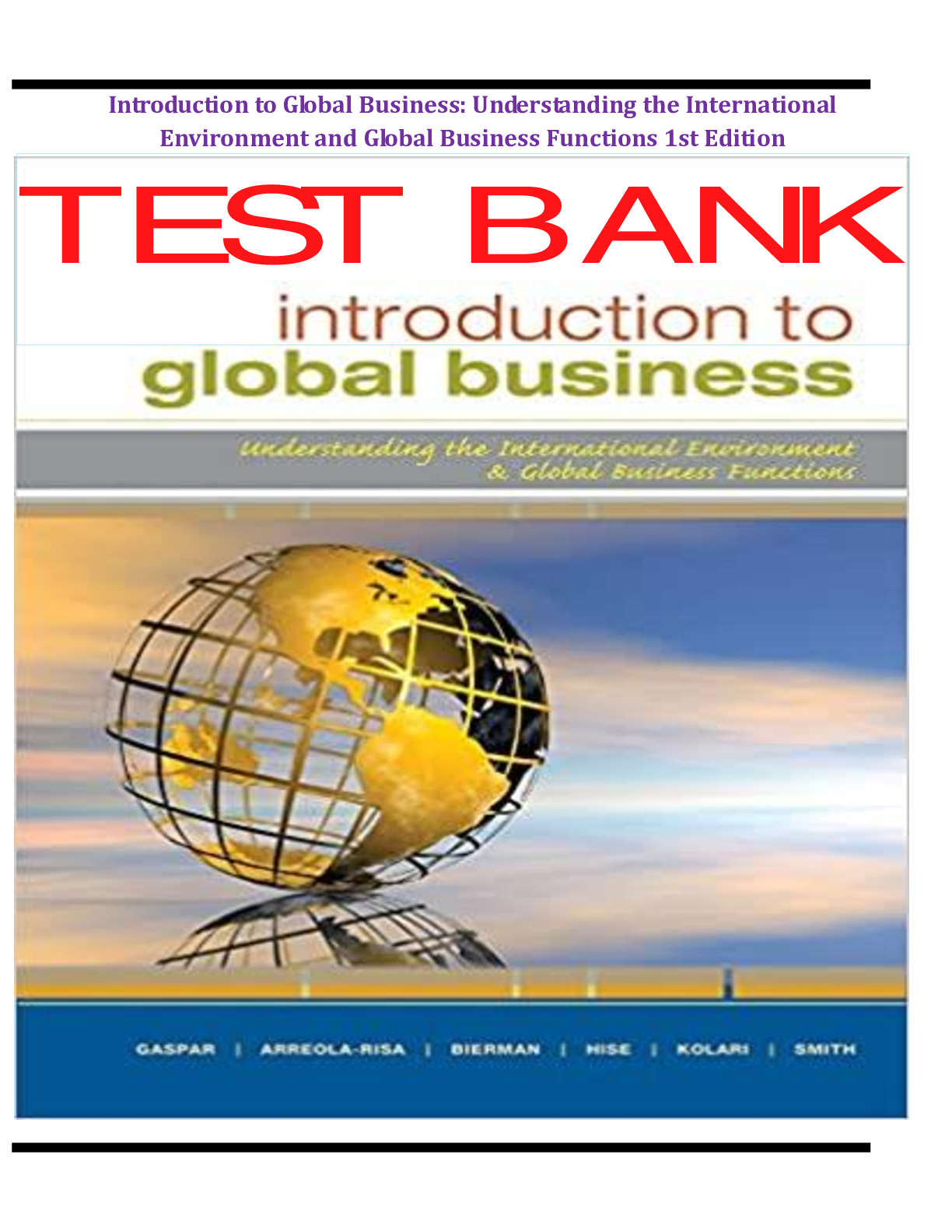
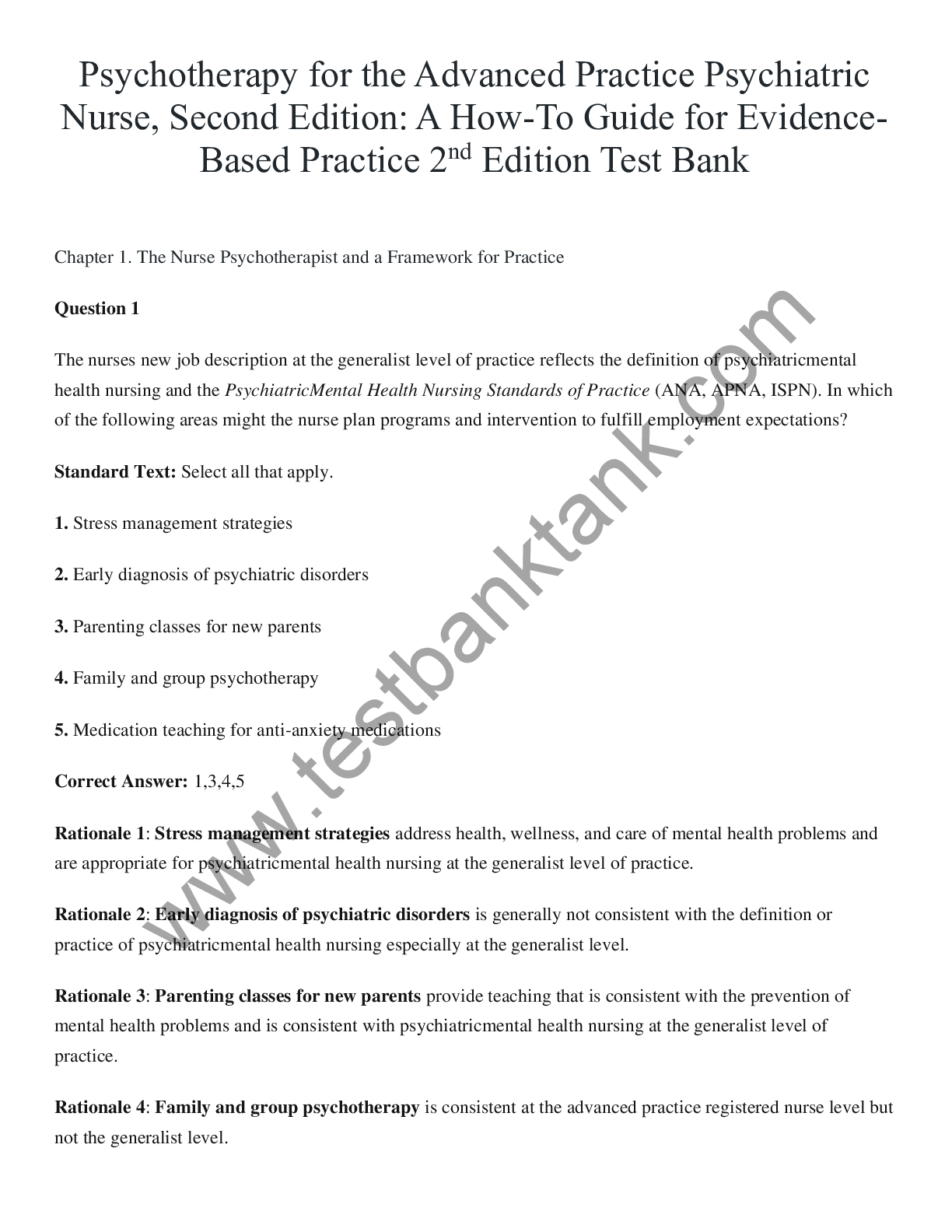


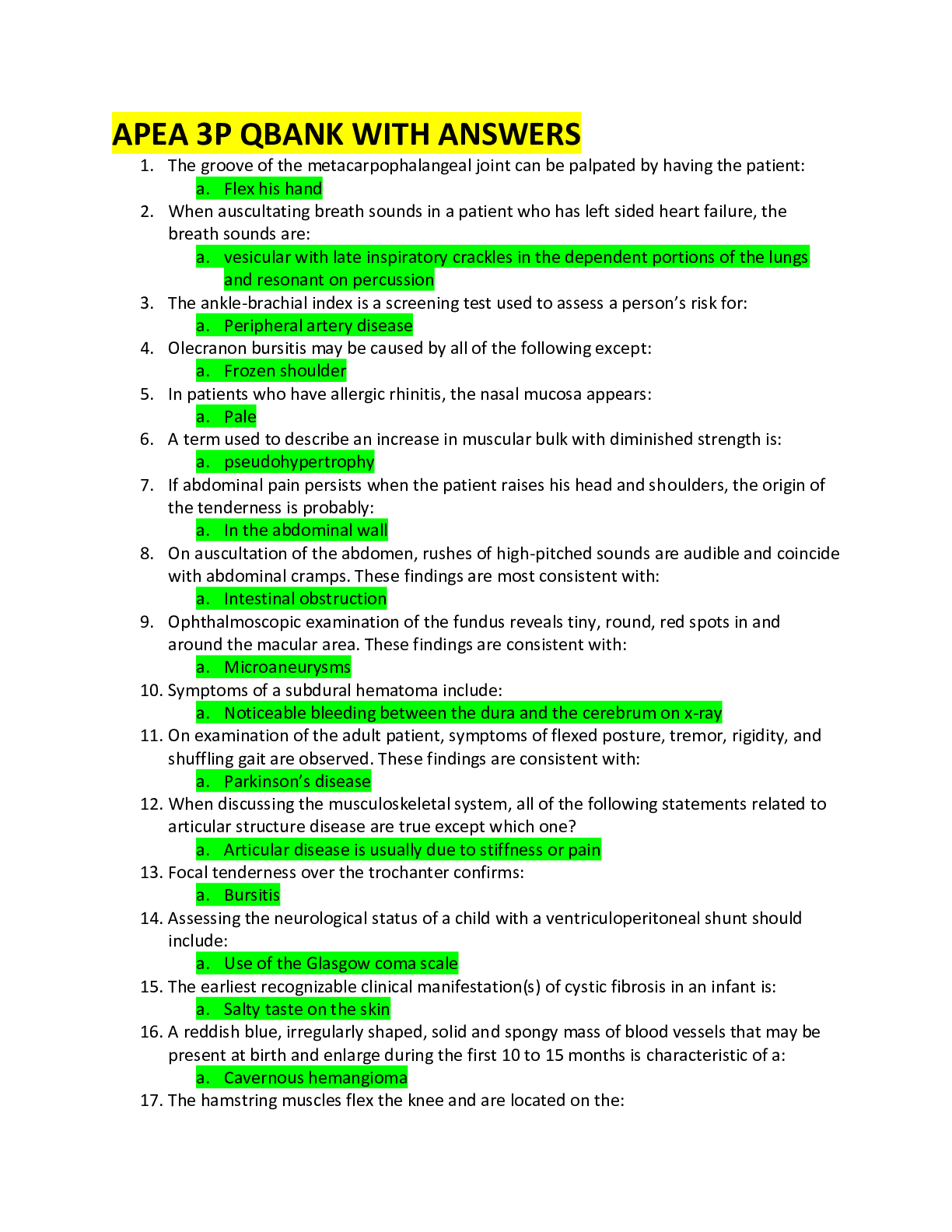




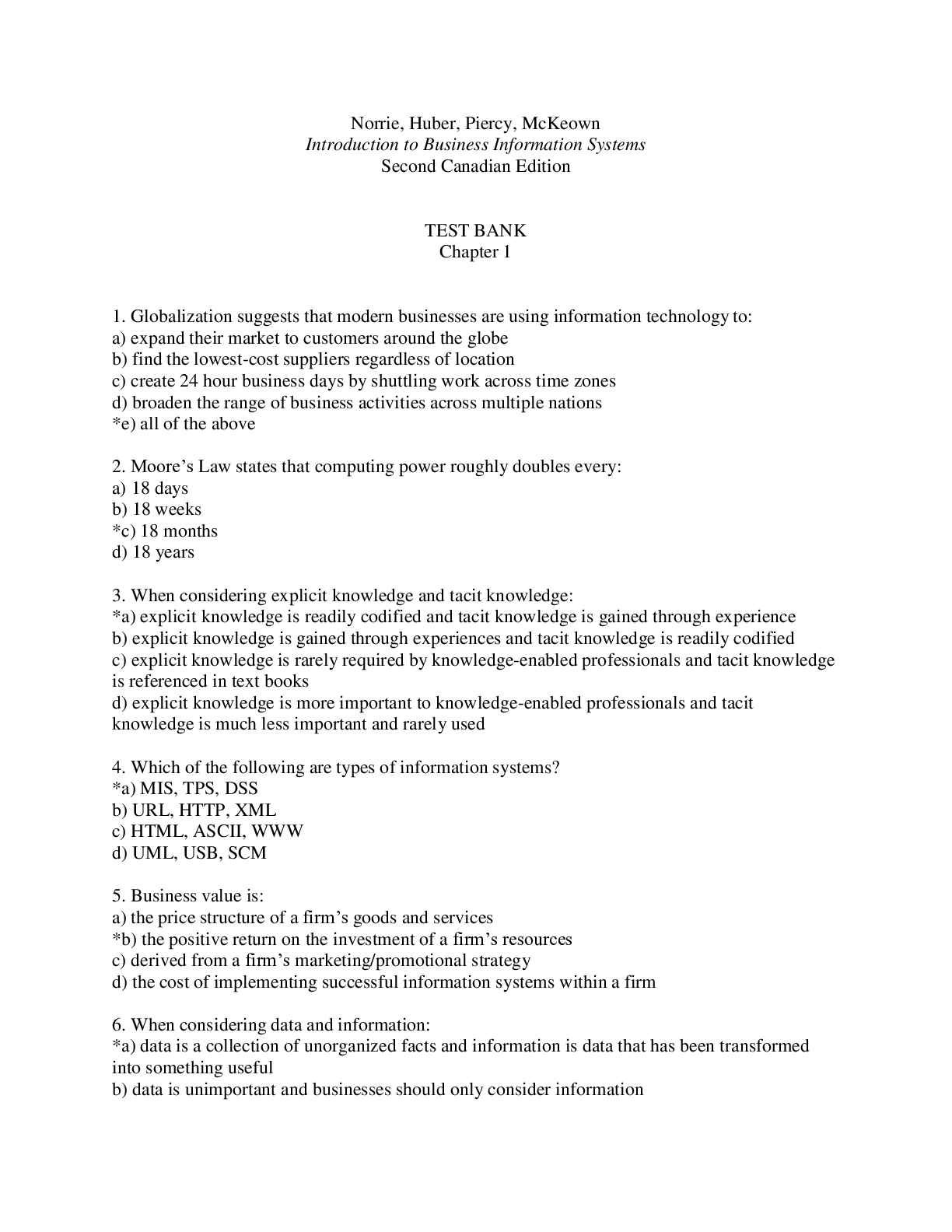




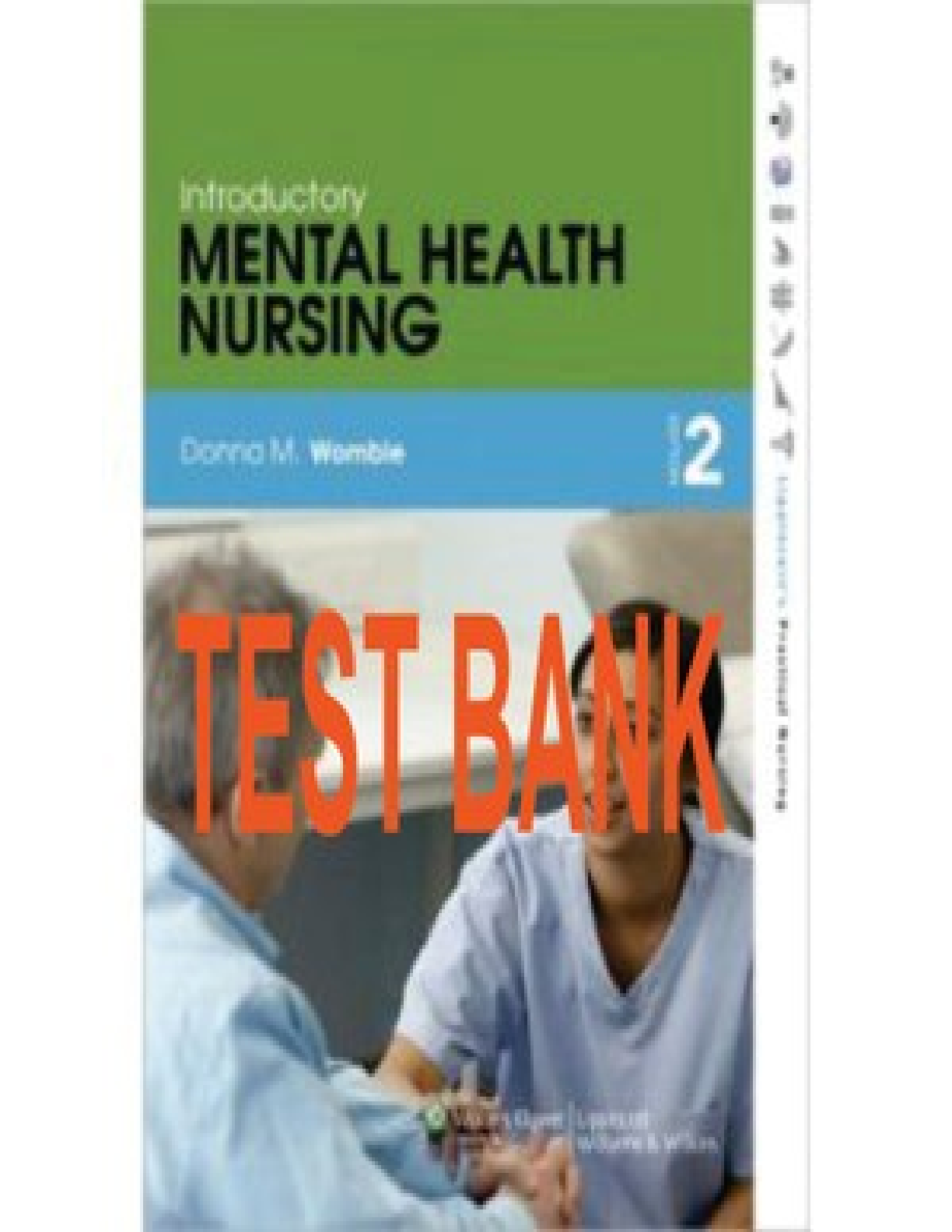
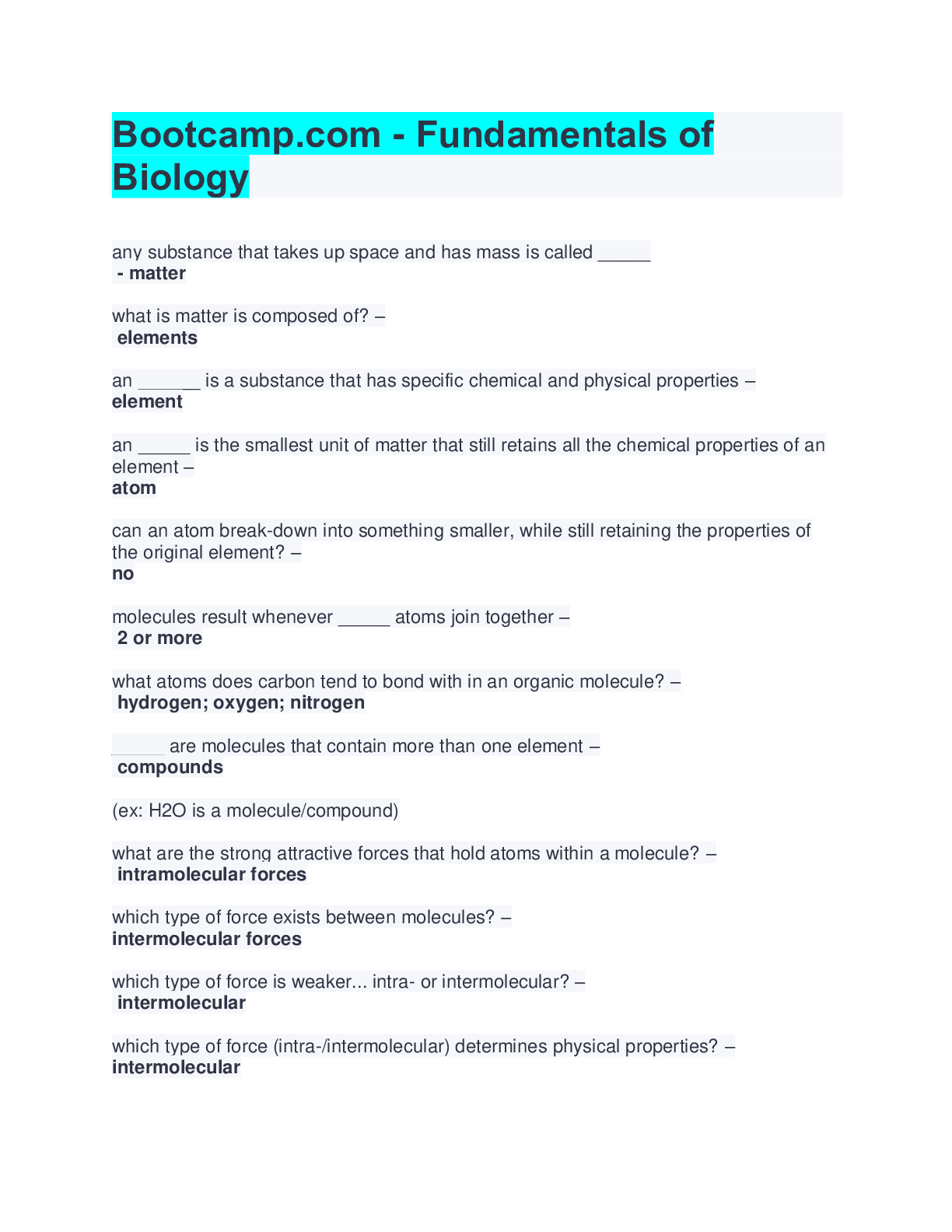
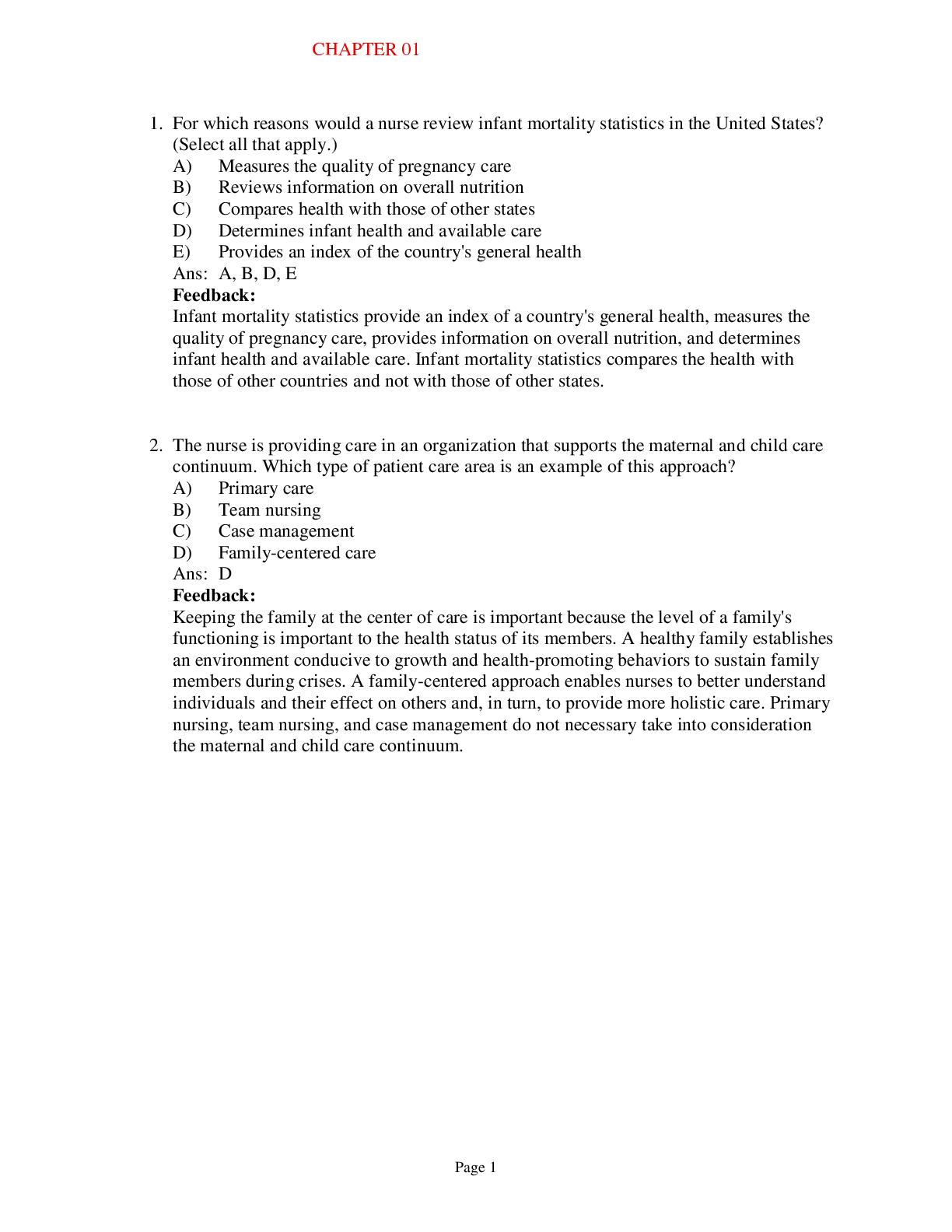
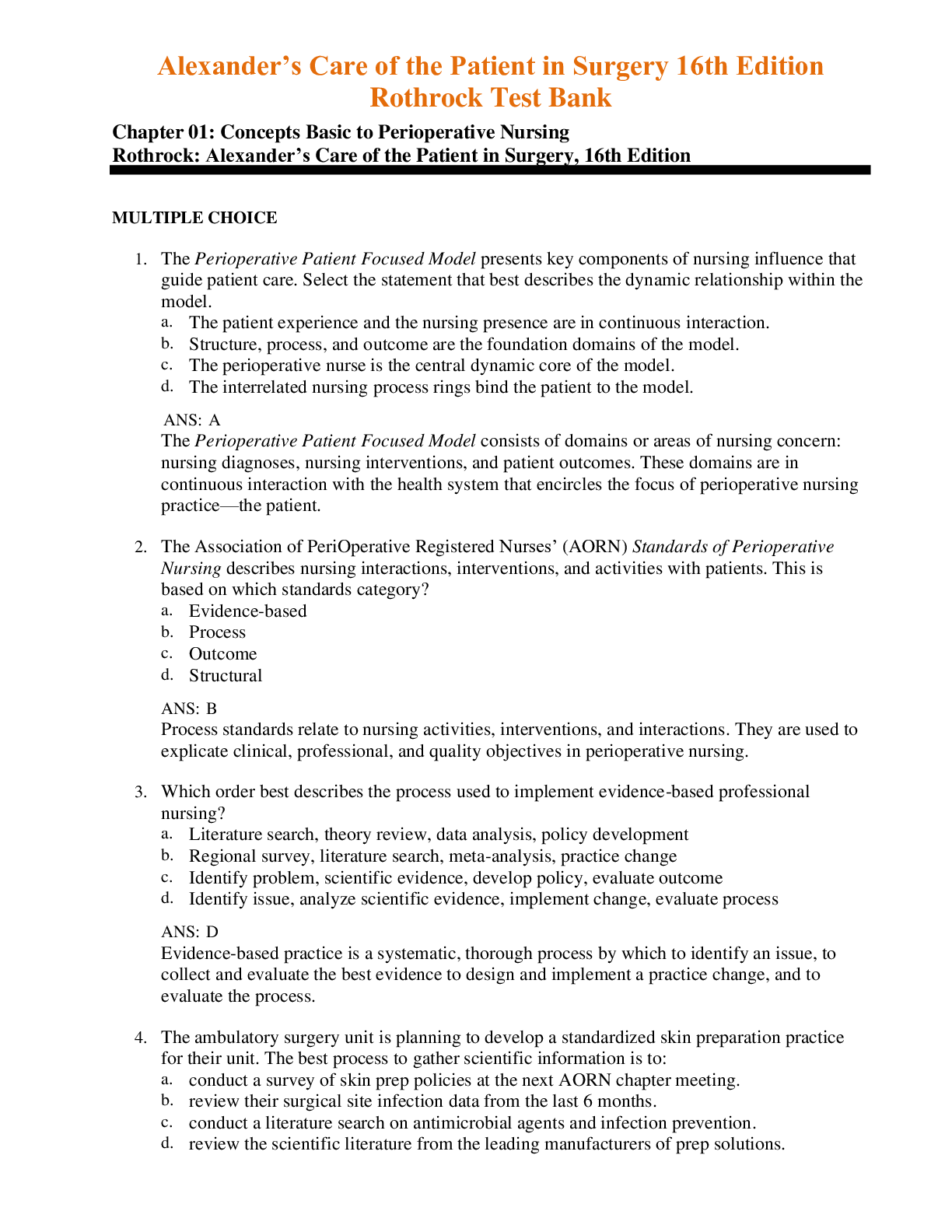
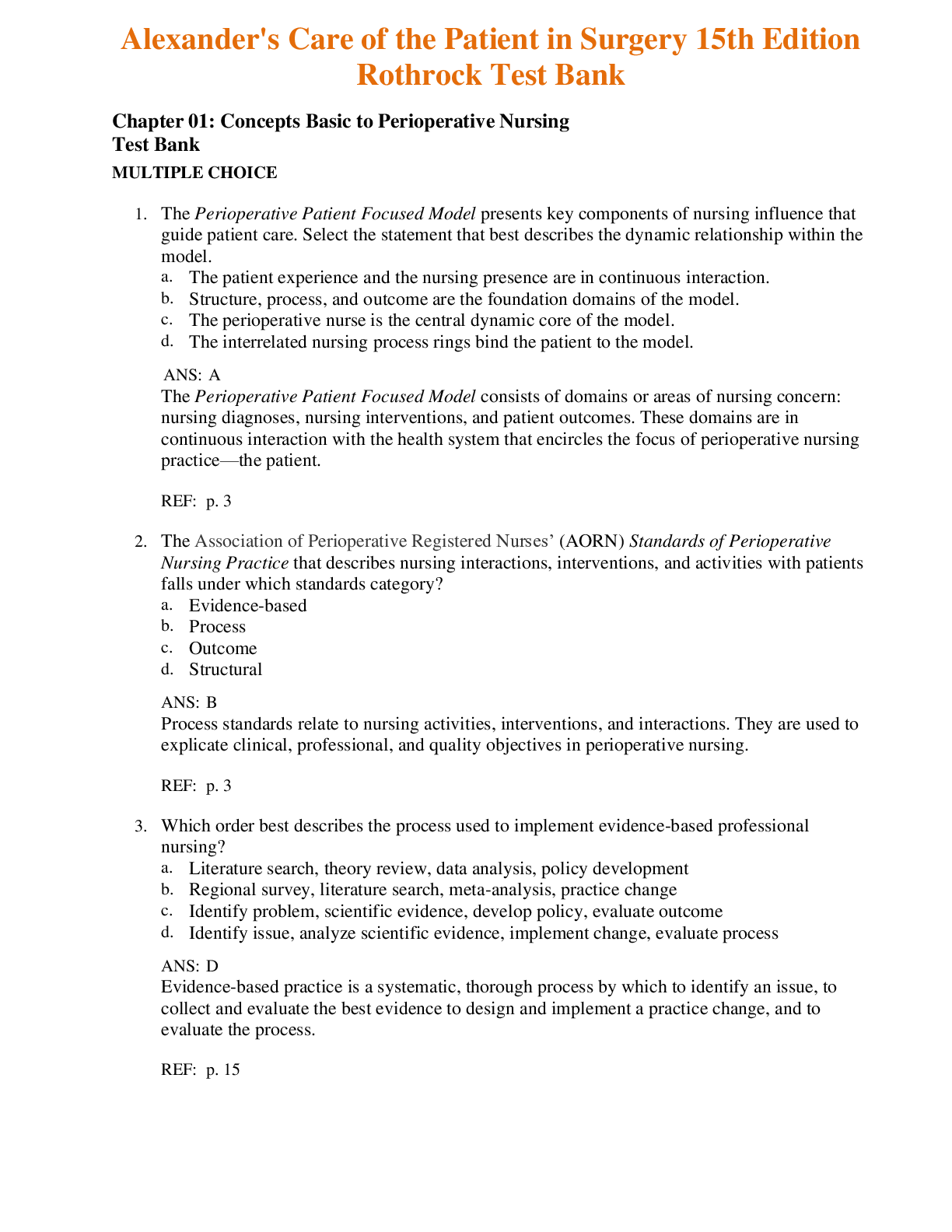
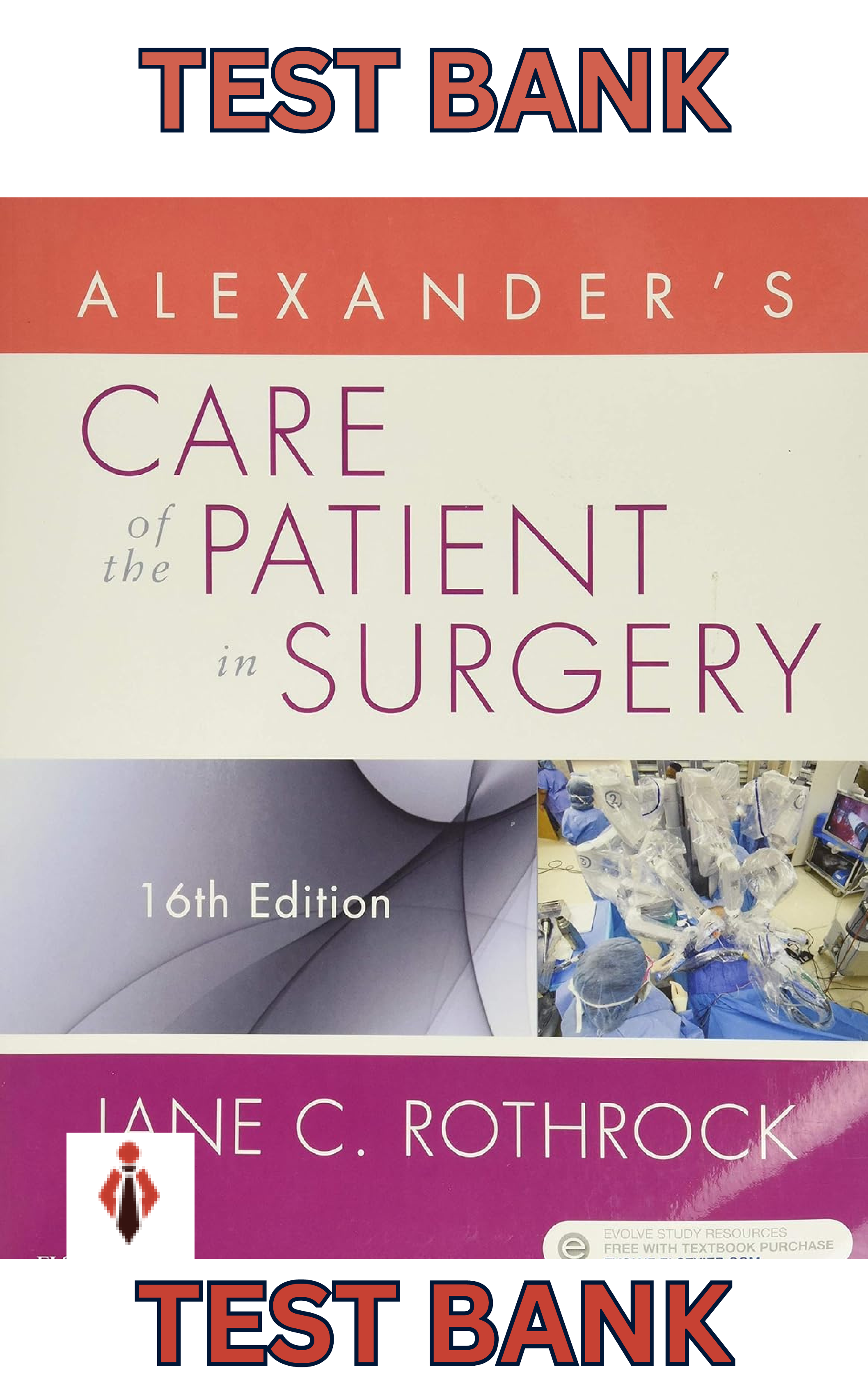
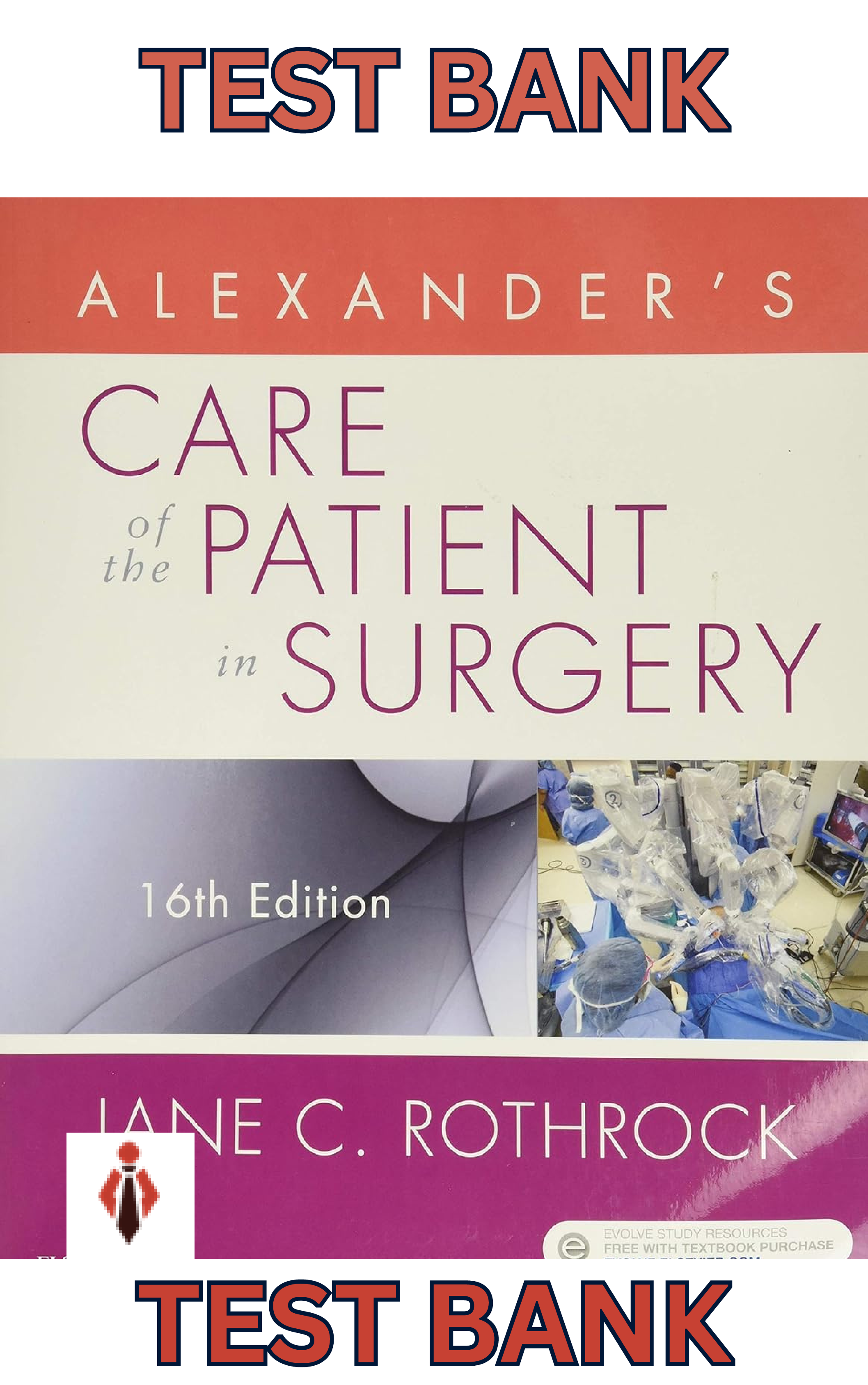
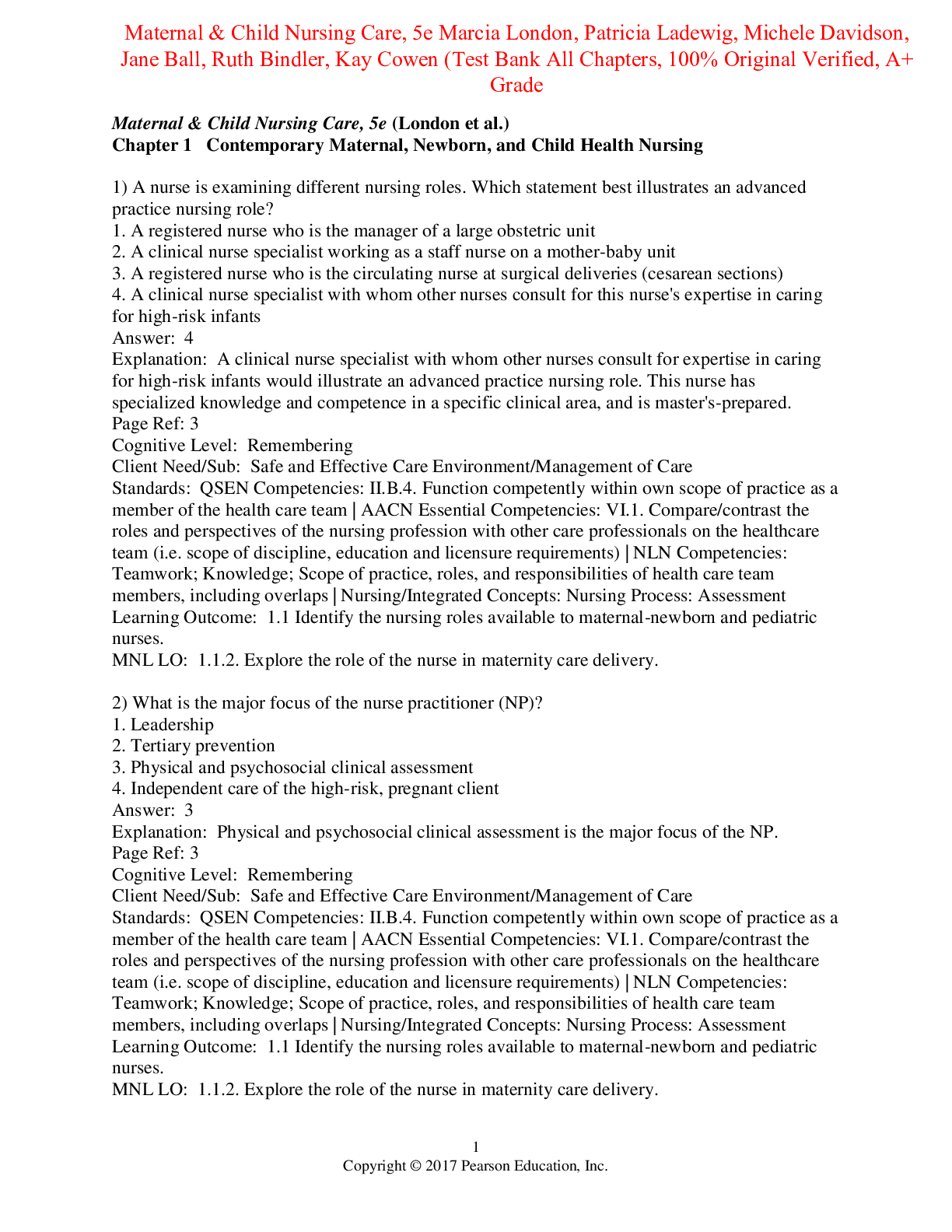
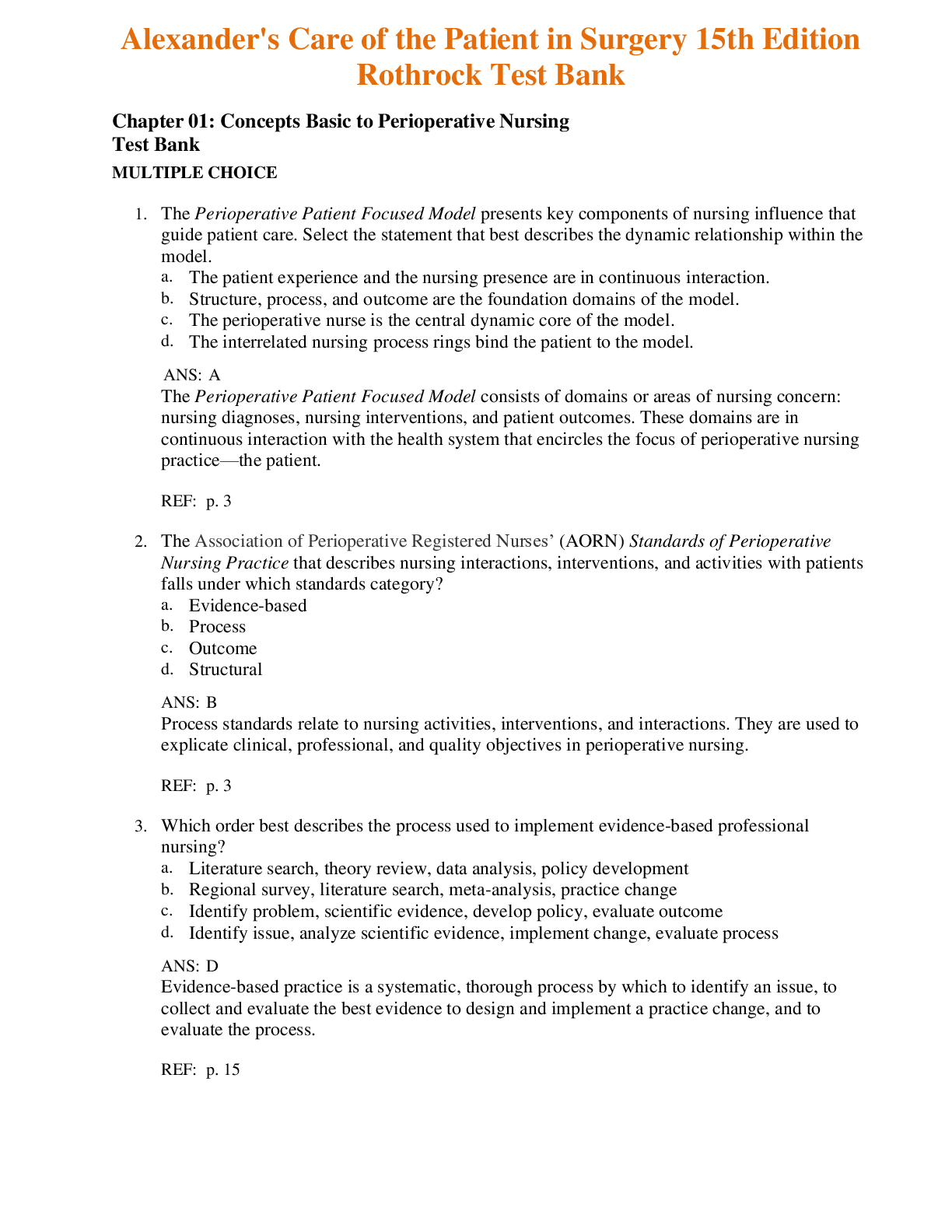
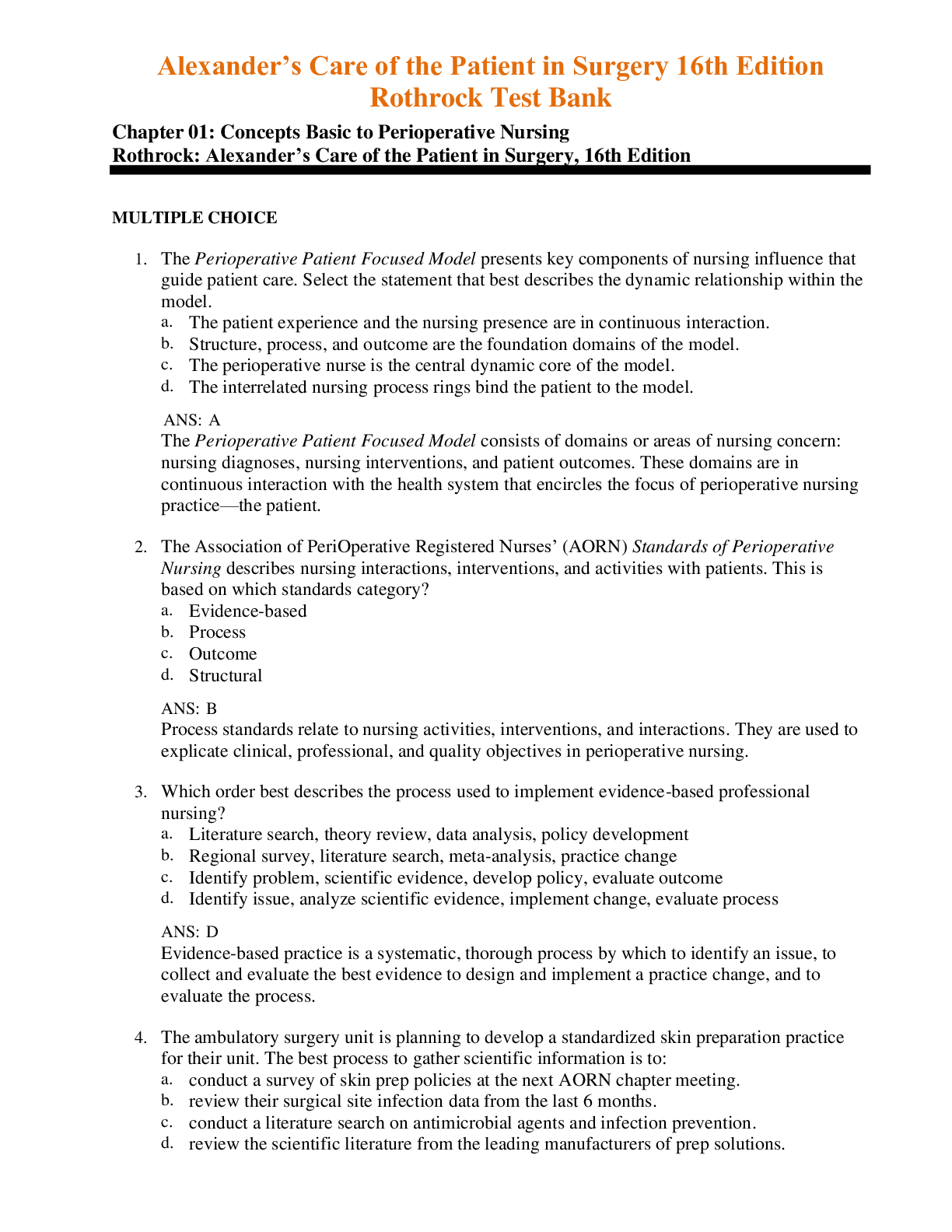
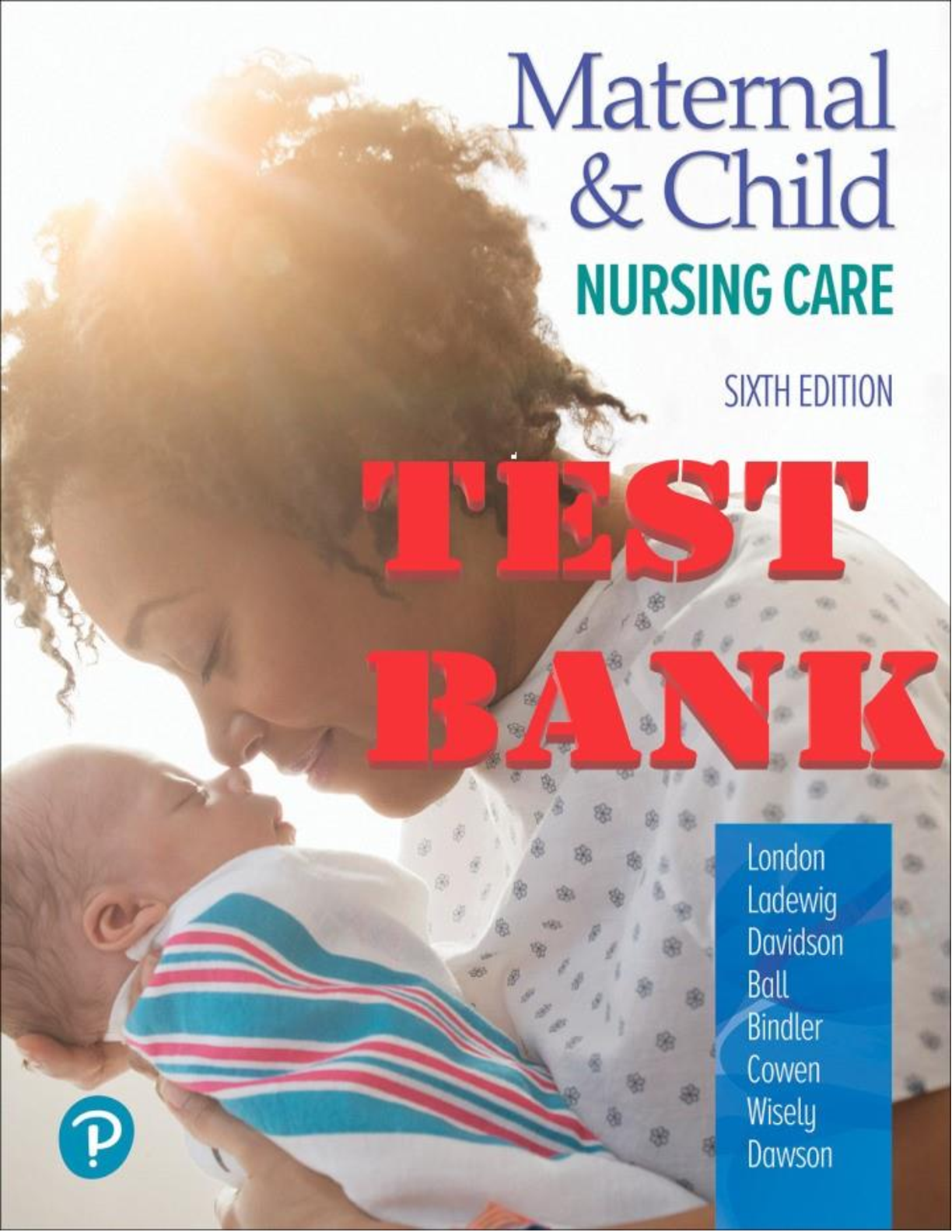
.png)

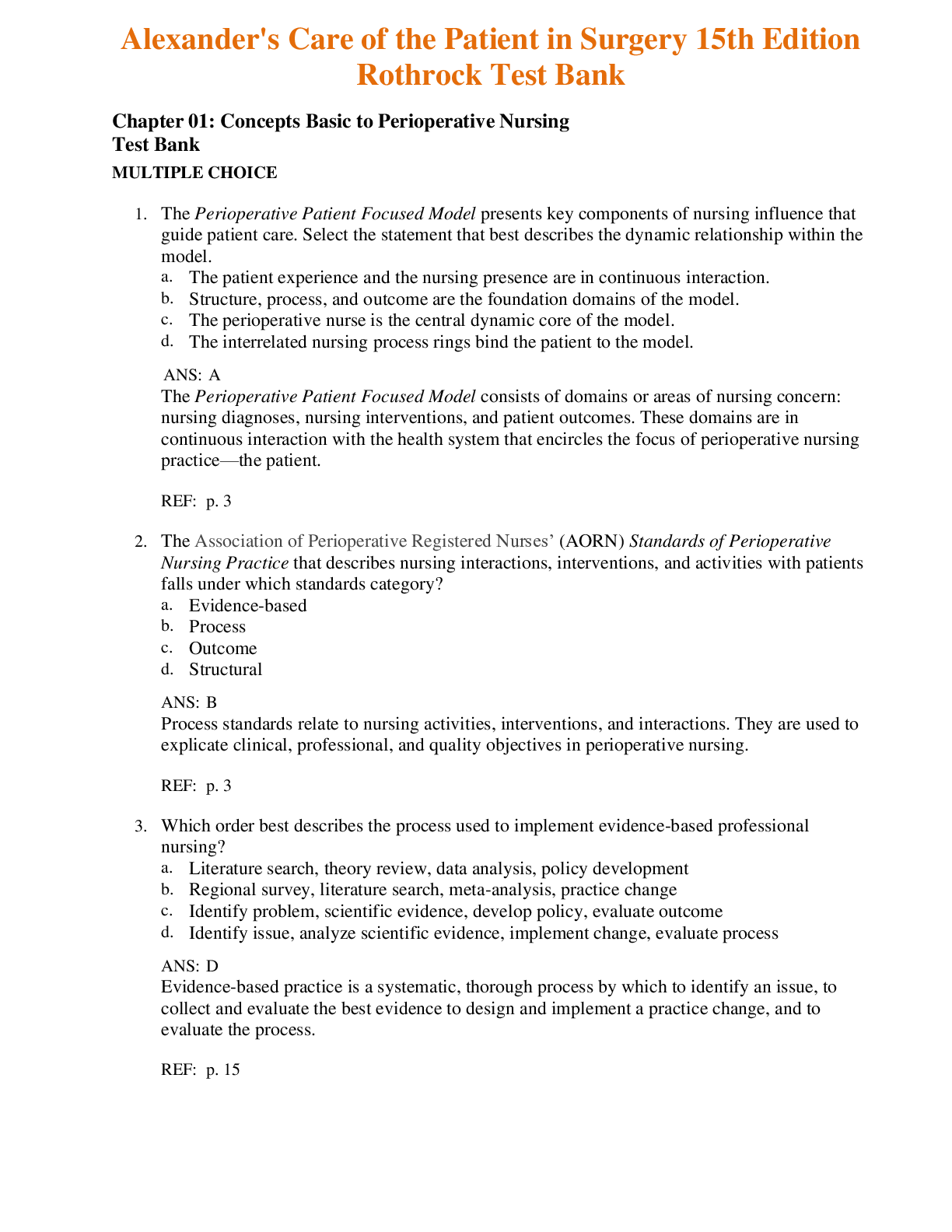
.png)


